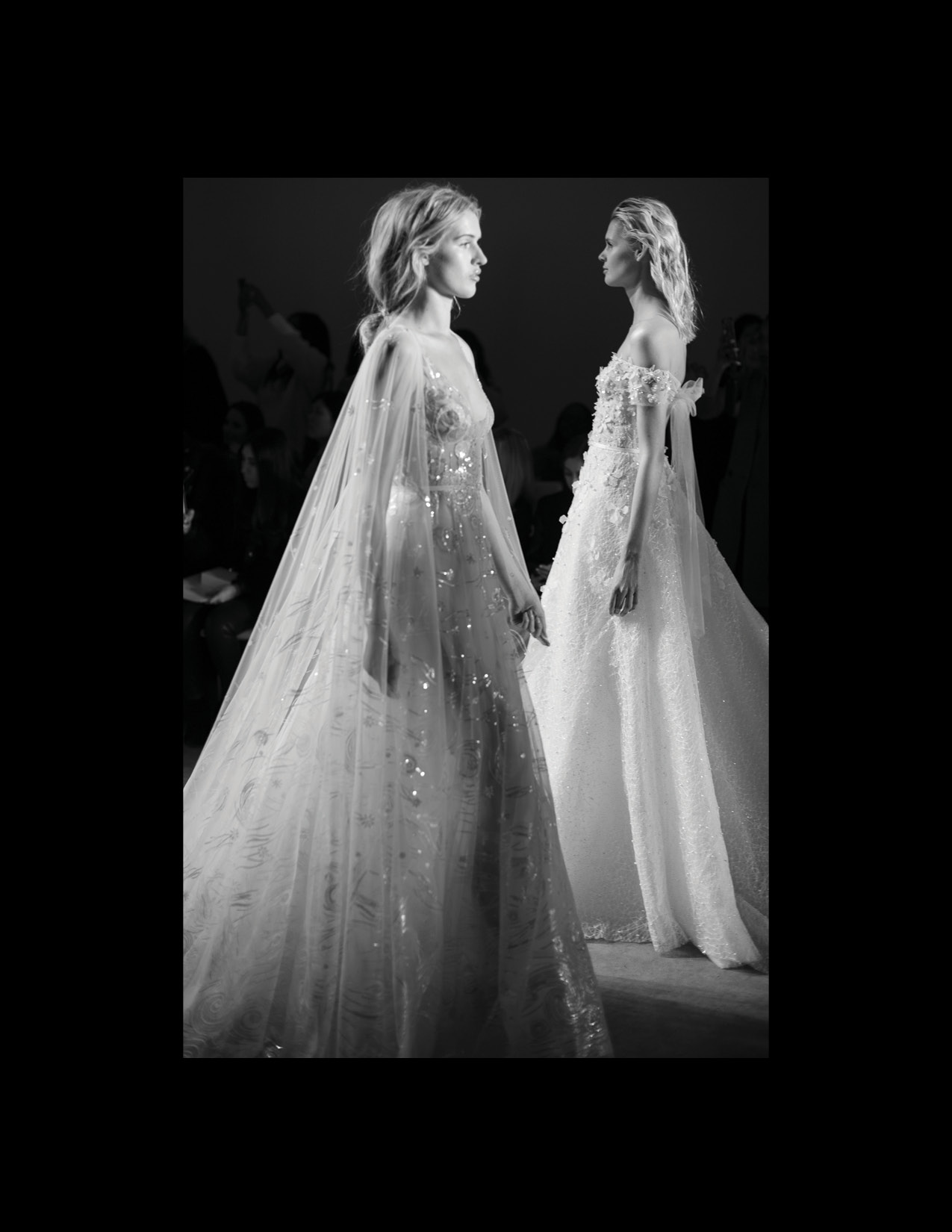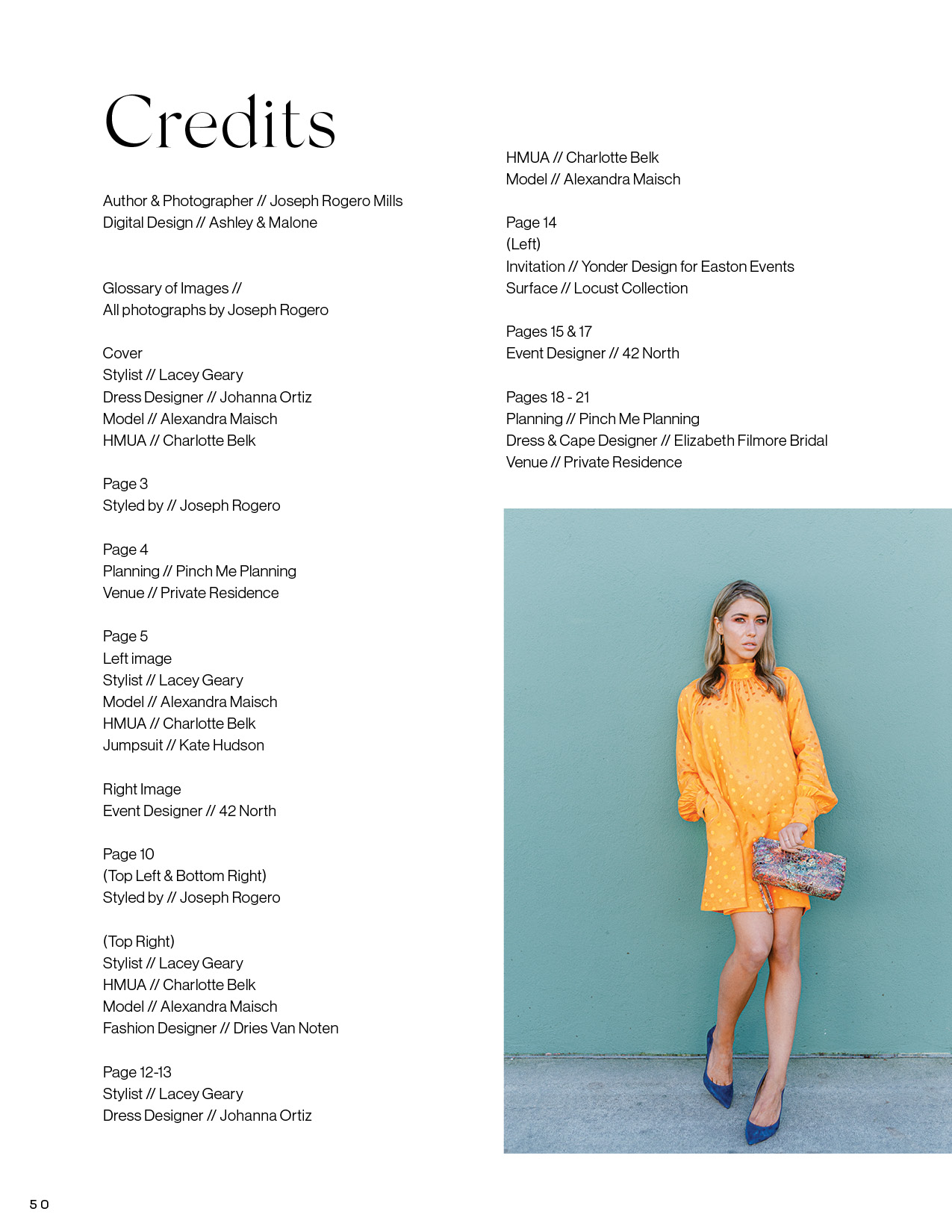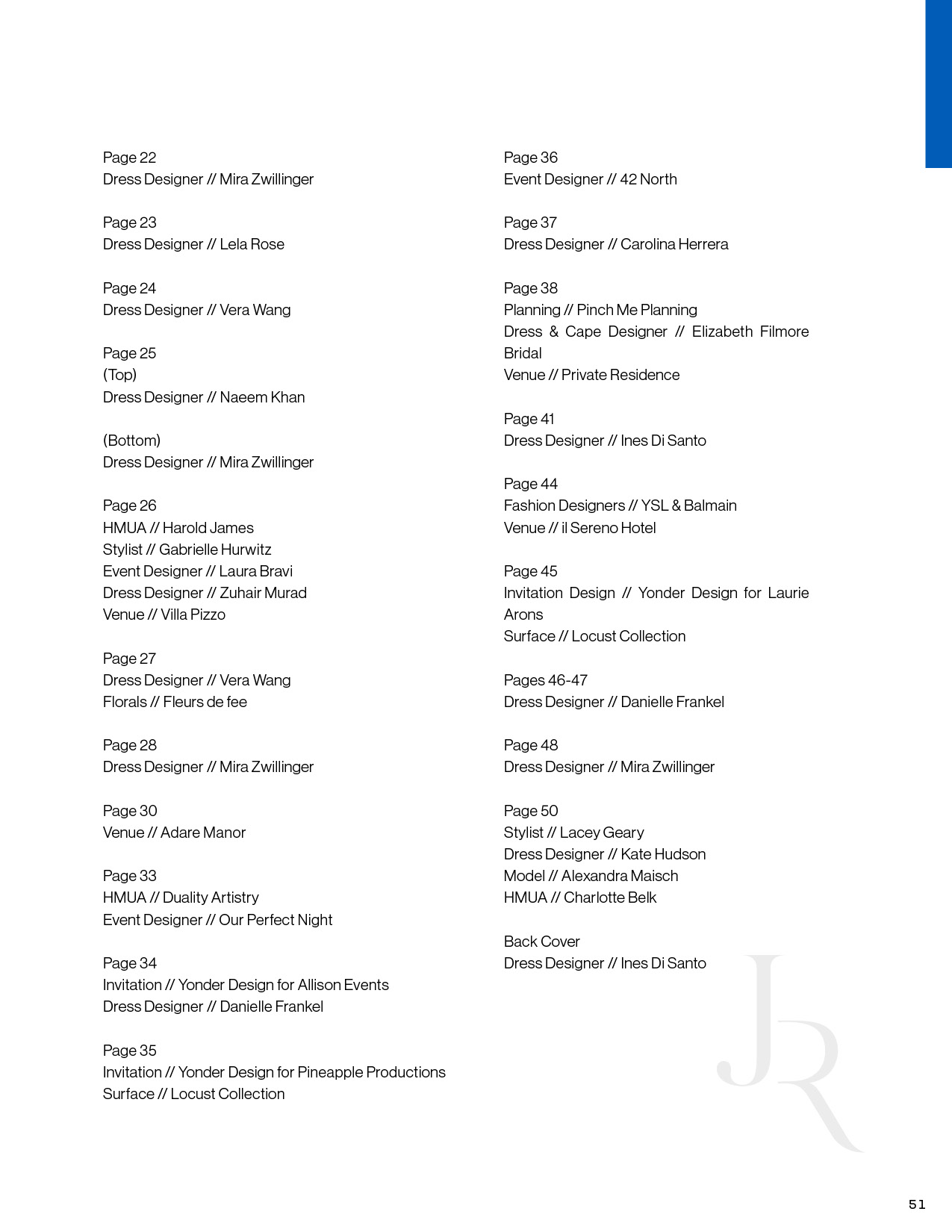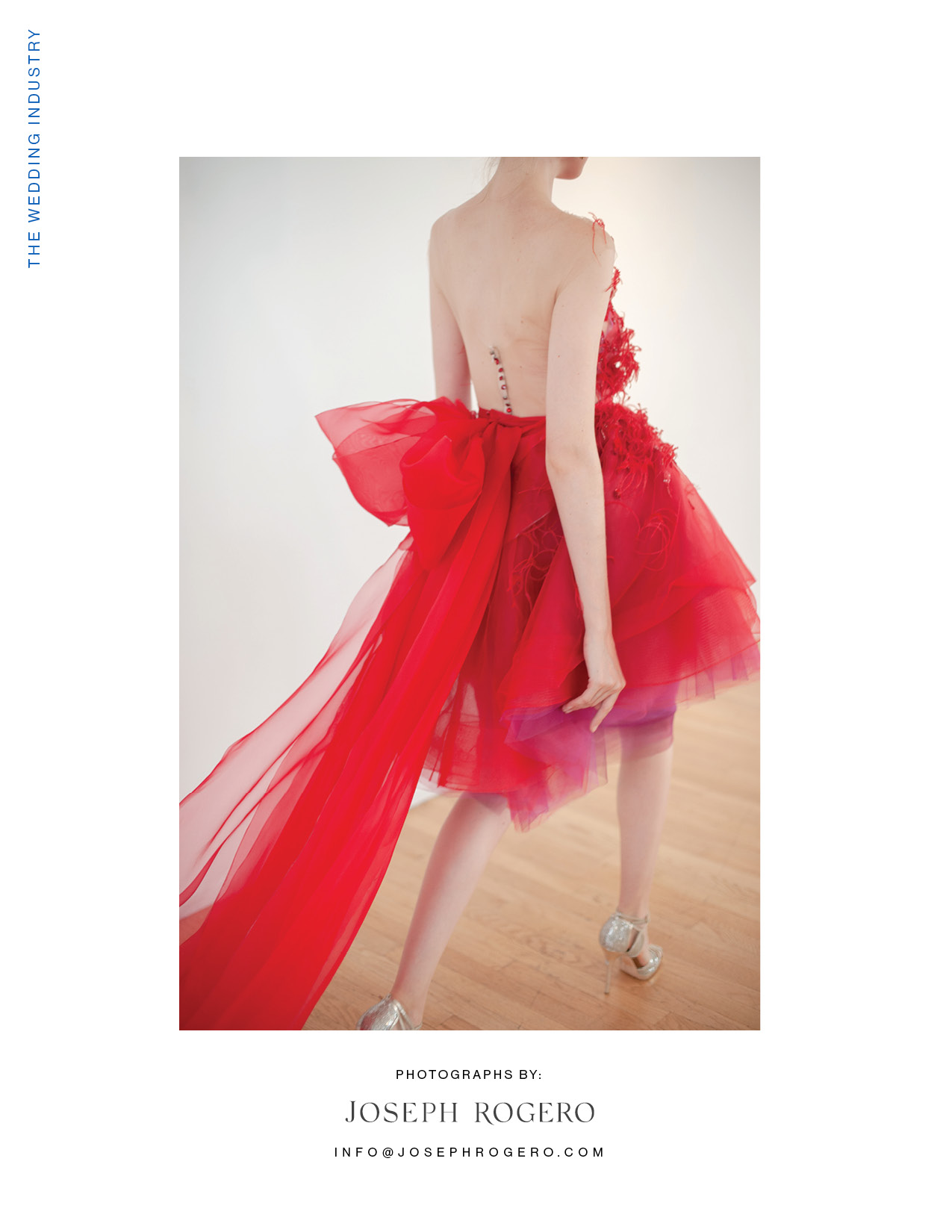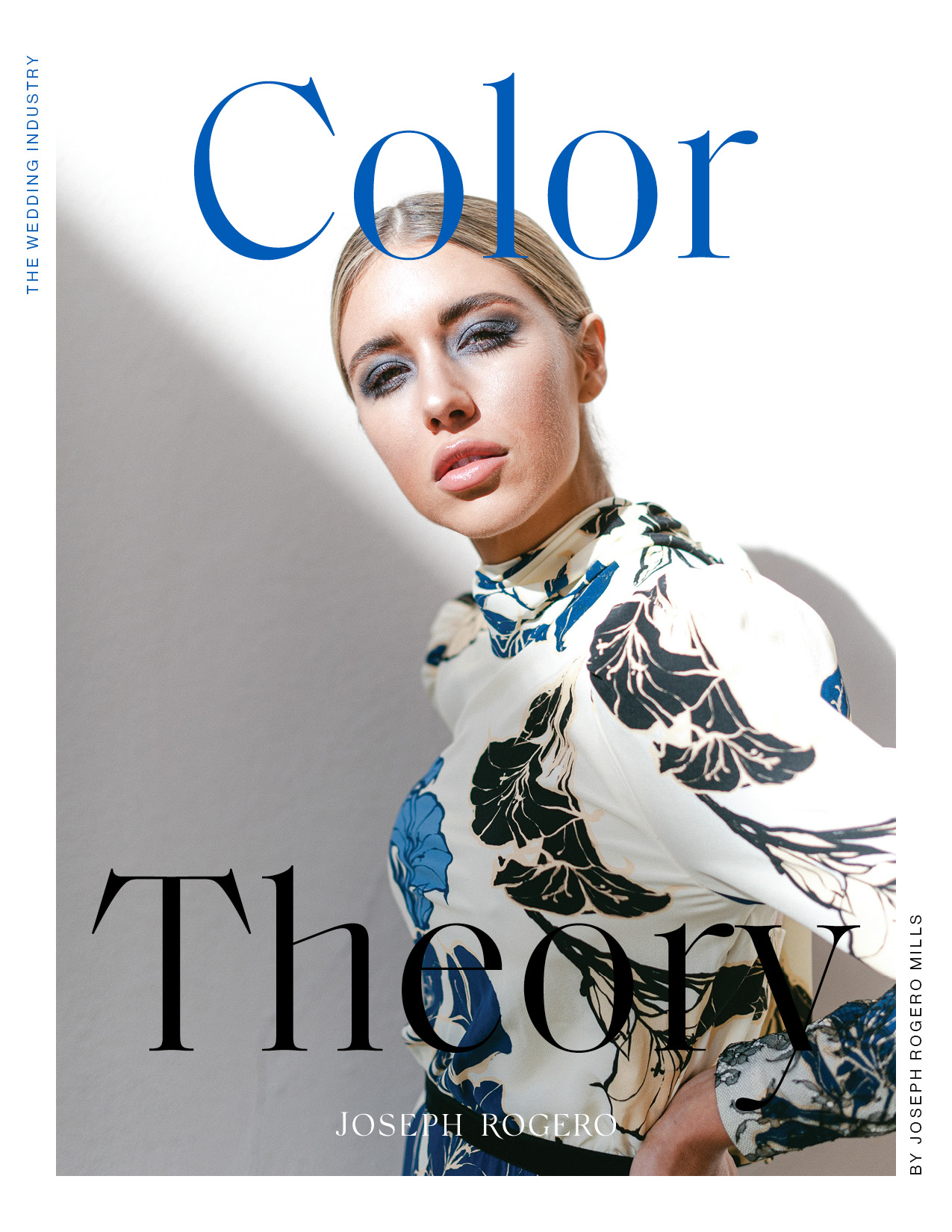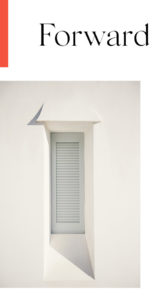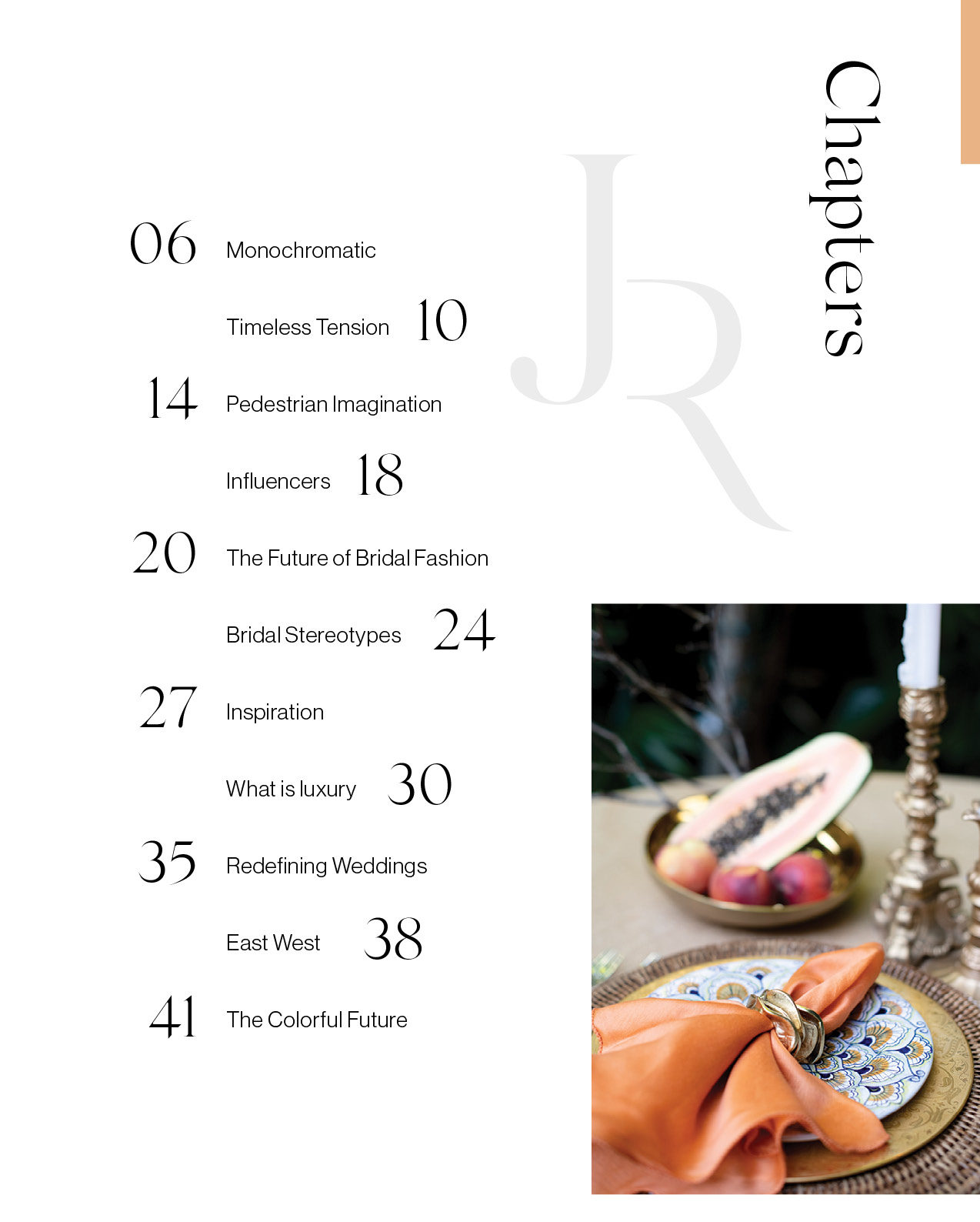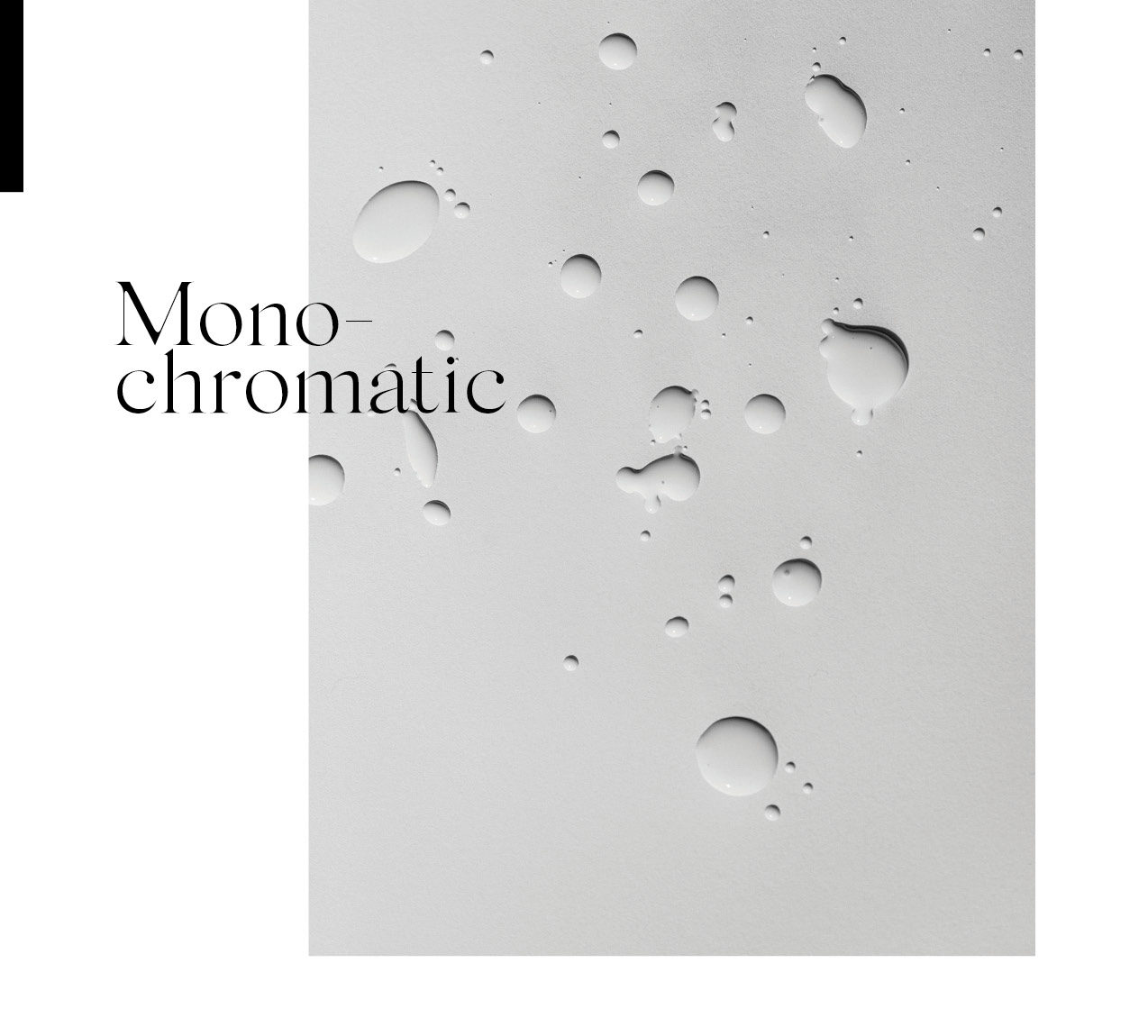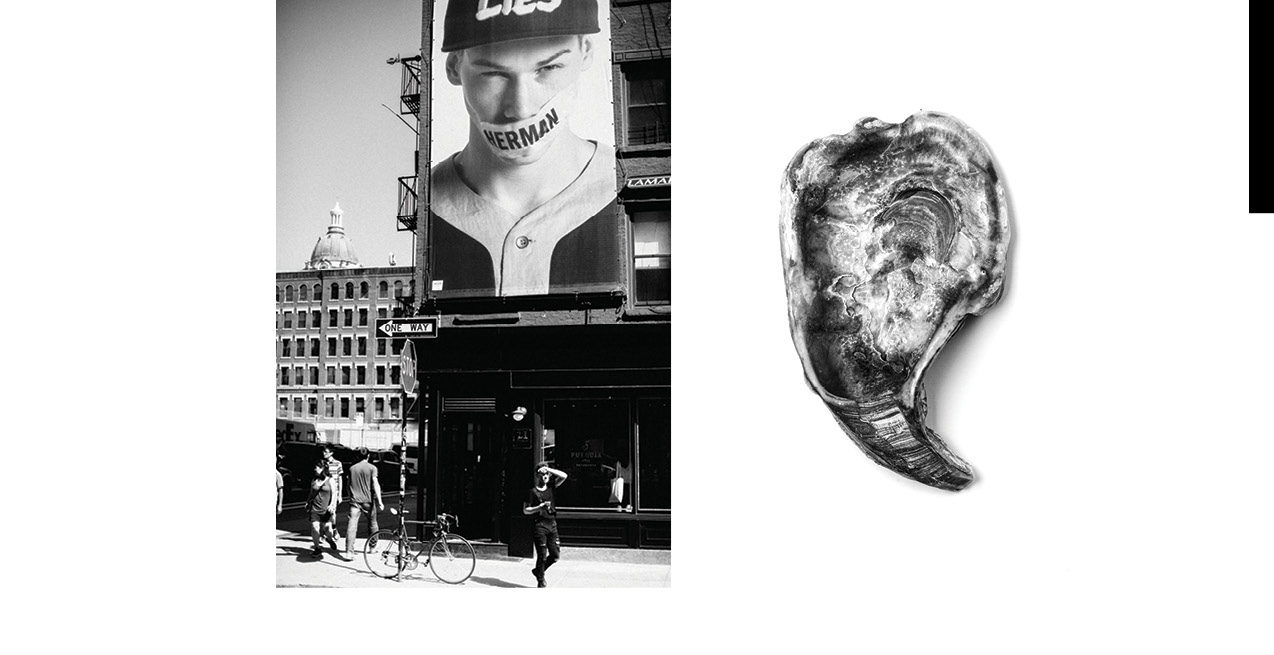Editorial
Color Theory
Photographed by: Joseph
// Download Color Theory by Joseph Rogero //
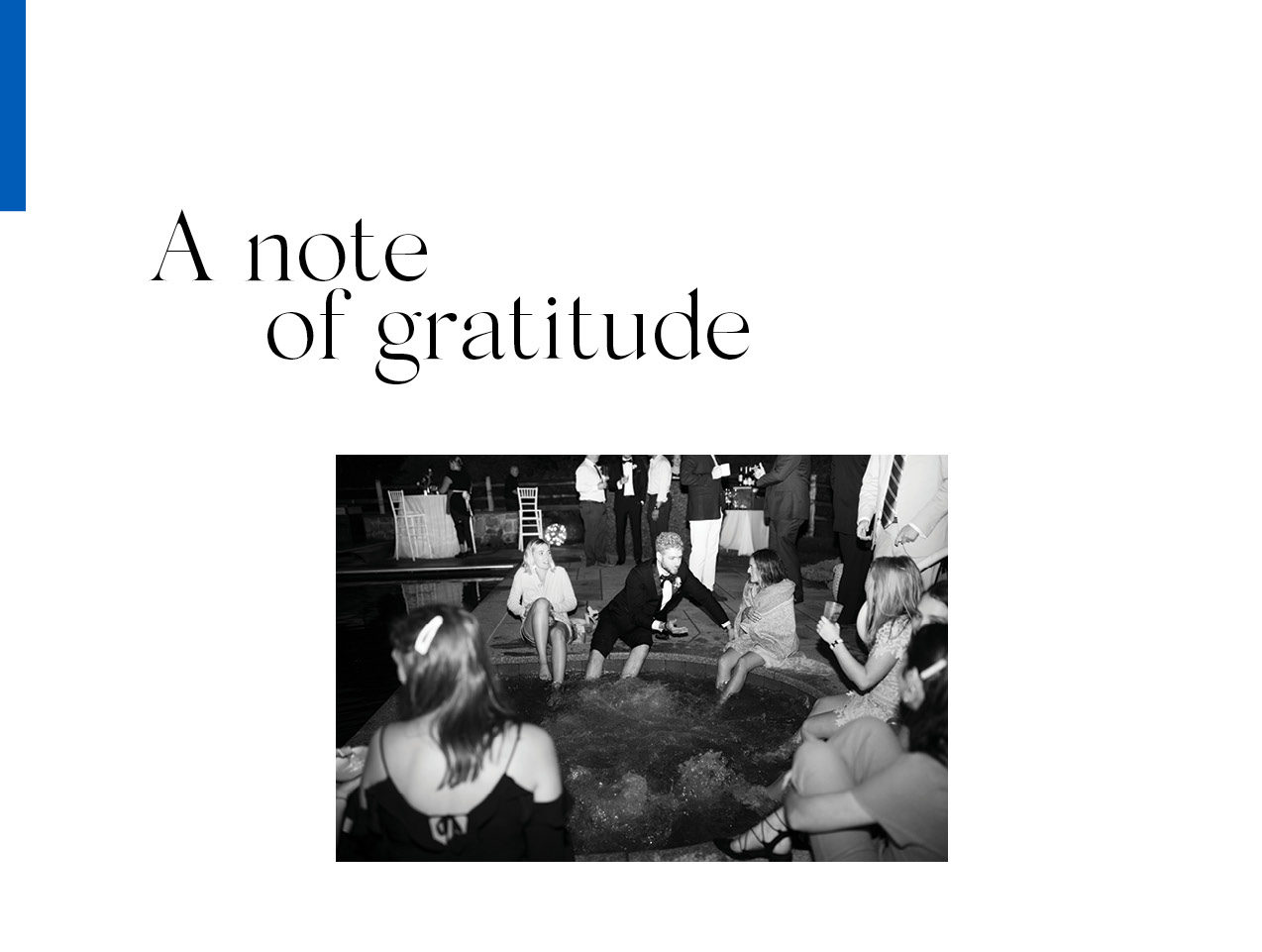
I am humbled for all of the time, honesty, and wisdom each contributor has extended for this work. After every conversation, I walked away with more knowledge and excitement for the possibilities. As Jesse Tombs said, “time is a luxury.” I realize all of you shared that luxury with me and I am incredibly grateful for that. I would also like to thank other contributors not showcased in conversation but within the supporting photographs. Christina Mills, Lacey Geary, Charlotte Belk, Locust Collection, Natalie Denyse and lastly I always smile big when I think of Ashley Malone our contributing designer for Color Theory. Without you, this would simply be a dream.
Thank you all for making this come to life! -JR
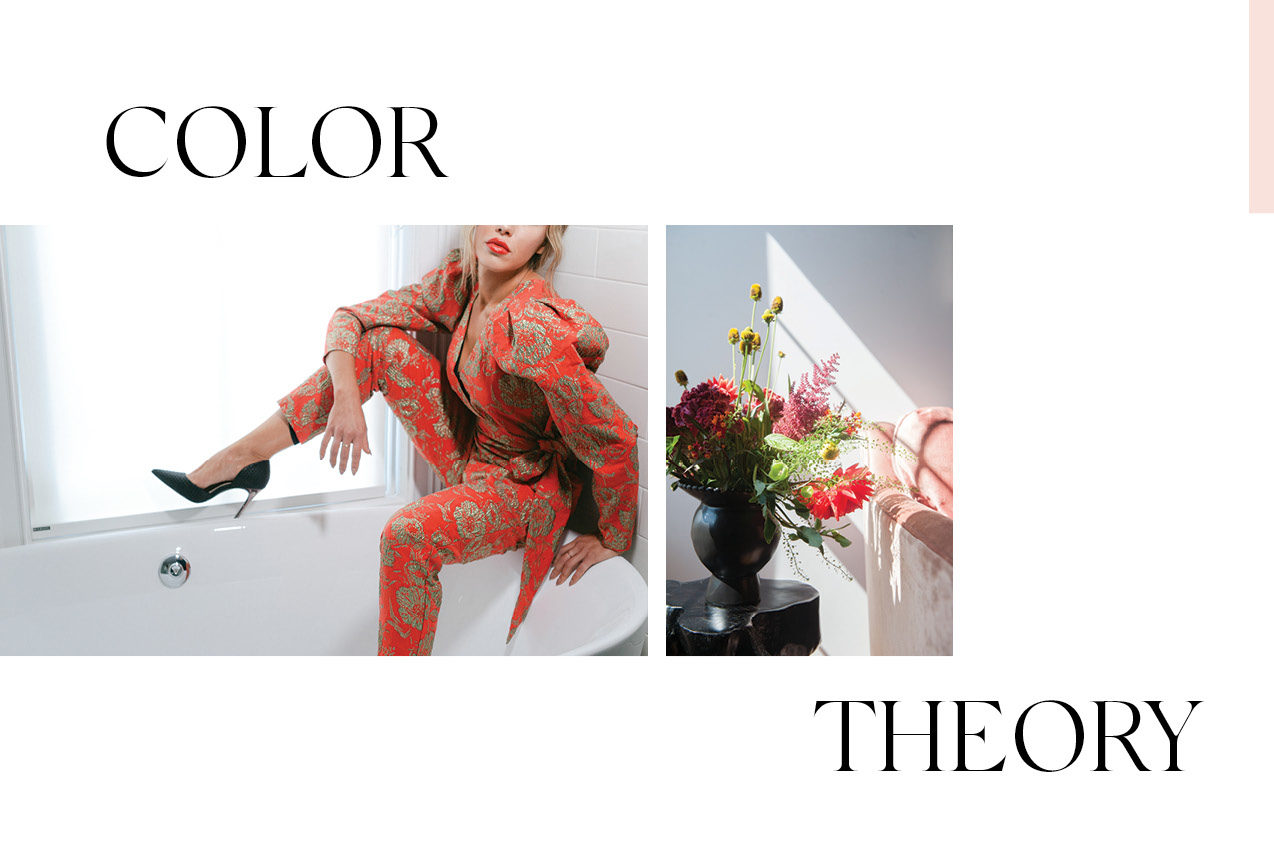
For much of my career shooting weddings, event design felt safe. Weddings of white, blush, and green were splashed across the pages of our favorite publications and saturated social media. It was evident that we – the industry creatives – were ready for disruption. Those celebrations lacked life, and spirit, and boldness in their own right. Our Color Theory contributors are constantly pushing themselves past the expected, infusing their work with innovative flair and the highest level of creativity and I’m eager to share their philosophies with you.
Color Theory shouldn’t be adhered to on a traditional, linear path, but rather as a resource that you’re free to discover with your own compass. Color is a small piece of the overall design spectrum, and in order to unlock the kaleidoscope, you have to unveil the why. Our contributors reflect on how color is central to the vision of each event not because of location or seasonality, but because it reveals itself through meaningful dialogue and personal time spent understanding who their clients are on a deeper level. And so, each section explores the mystery and artistic expression of each color concept.
Color Theory is a composition of thought-provoking conversations with some of our country’s top creative minds in the wedding industry that explores color in design and unveils its dichotomy with timelessness. Inside this short journal, wedding creatives, producers, florists, and stylists share the narrative of couples and families from around the world and how those cultures, traditions, and expectations reflect the design and guest experiences they integrate into their craft. Each brings a unique perspective on the tension and application of color, patterns, textures, and prints.
As a wedding photographer, I strive to be hyper-aware through the emotional unfoldings of my clients during the day. I quickly learned that these creatives do the same when producing their work. When starting my career, I realized that there were two paths I had the choice of traveling. The safer path felt like a rinse and repeat prescription that would yield similar results no matter the uniqueness of my subject or surroundings. The other route, vulnerable and jarring, would force my eyes wide open for what the day might bring in each moment, capturing the emotions that intersect one another leaving expectations at the door and accepting the raw, unfiltered beauty of now. Years ago I chose the latter and haven’t looked back.
As a new chapter unfolds, we are faced with an incredible frontier of opportunity. And I hope that this resource challenges your mindset, inspires your senses, and encourages deeper creative exploration for you and your couples as we continue to redefine the meaning of wedding celebrations.
Removing color from something simplifies the composition, it removes noise, focuses emotion and leaves an instant nostalgic stain that reminds our subconscious of timeless works of art made in black and white. Robert Frost, Richard Avedon, Audrey Hepburn, Jackson Pollock, John Coltrane, and countless others were monochromatic legends forever displayed on a gray-scale. So with that thought, I wanted to explore what others had to say about the neutral palette play that seems to be an overwhelming choice for so many in our modern age. -JR
“Traditionally, luxurious brands tend to lean on minimalism regarding color. They have a very black and white styled aesthetic specifically for their branding – their core colors, the text on their site and graphics. The color is brought in through their collections, many colors change from season to season, that’s why their brand colors are rooted in the classic monochromatic tones. It’s less about standing out and more about establishing themselves.”
– Ashley Malone, Ashley & Malone
“Think about a woman wearing one color and what makes it chic is the drape of the fabric. I think the same for a monochromatic event. You’re not fussing over what was done with the blues and greens. Rather you focus on the event and listen to the music and look at the food. The fussiness goes away and it’s more about the texture, the layering and how uniform and simple everything looks.”
– Britt Cole, 42 North
“There is something valid about neutrals being the safest definition of timeless because they will never go out of style. You can play with neutrals in a very elegant way forever. If you’re renovating a home to sell the first thing you do is neutralize the home to make it palatable to the broad audience. In terms of great taste and great style, the great homes of the world, the great interior designers, the great artists – they’ve never shied away from mixing color, pattern, and texture.”
– Augusta Cole, Weddings & Events
“There is a fear [of color]. There have been so many weddings photographed so when we do see the black and white images – from a royal wedding to celebrities to the Jackie O days – there is a sense of timelessness and most brides and couples want to feel that. Color is a hard sell, it’s got to take the right bride to pull it off.”
– Sofia Crokos, Events & LIFESTYLE
“For some people, a white wedding is the only thing that is acceptable and it’s enough for a neutral palette to make the couple shine. Some people don’t want to be upstaged and white will not upstage you, it will enhance you. I pretty much always go with white for a ceremony because it is a sacred color that provides light and a sacredness to the space that color would not. Colors have emotions within them, and you want your ceremony to be devoid of emotions so that the emotion can focus on the couple.”
– David Beahm, Experiences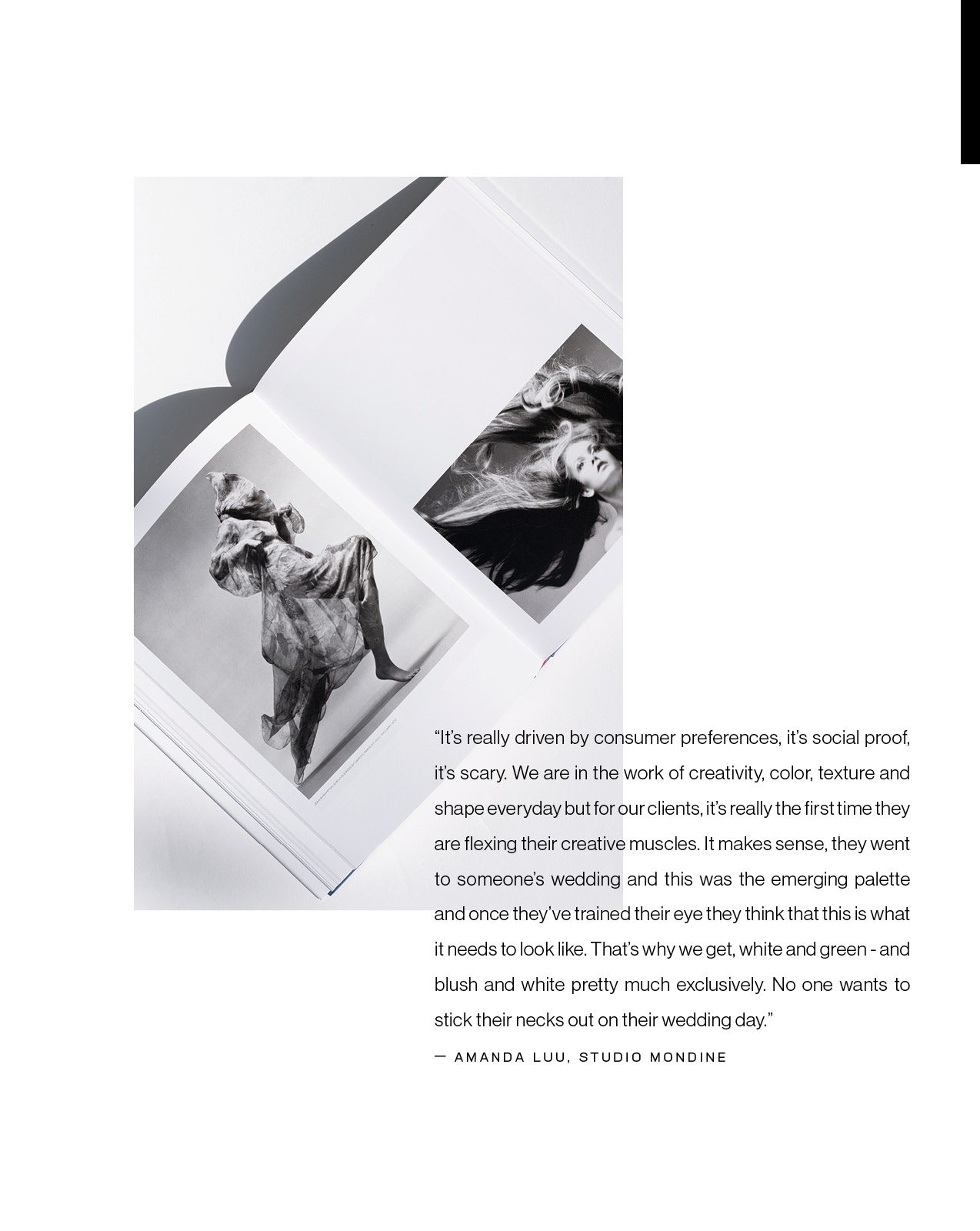
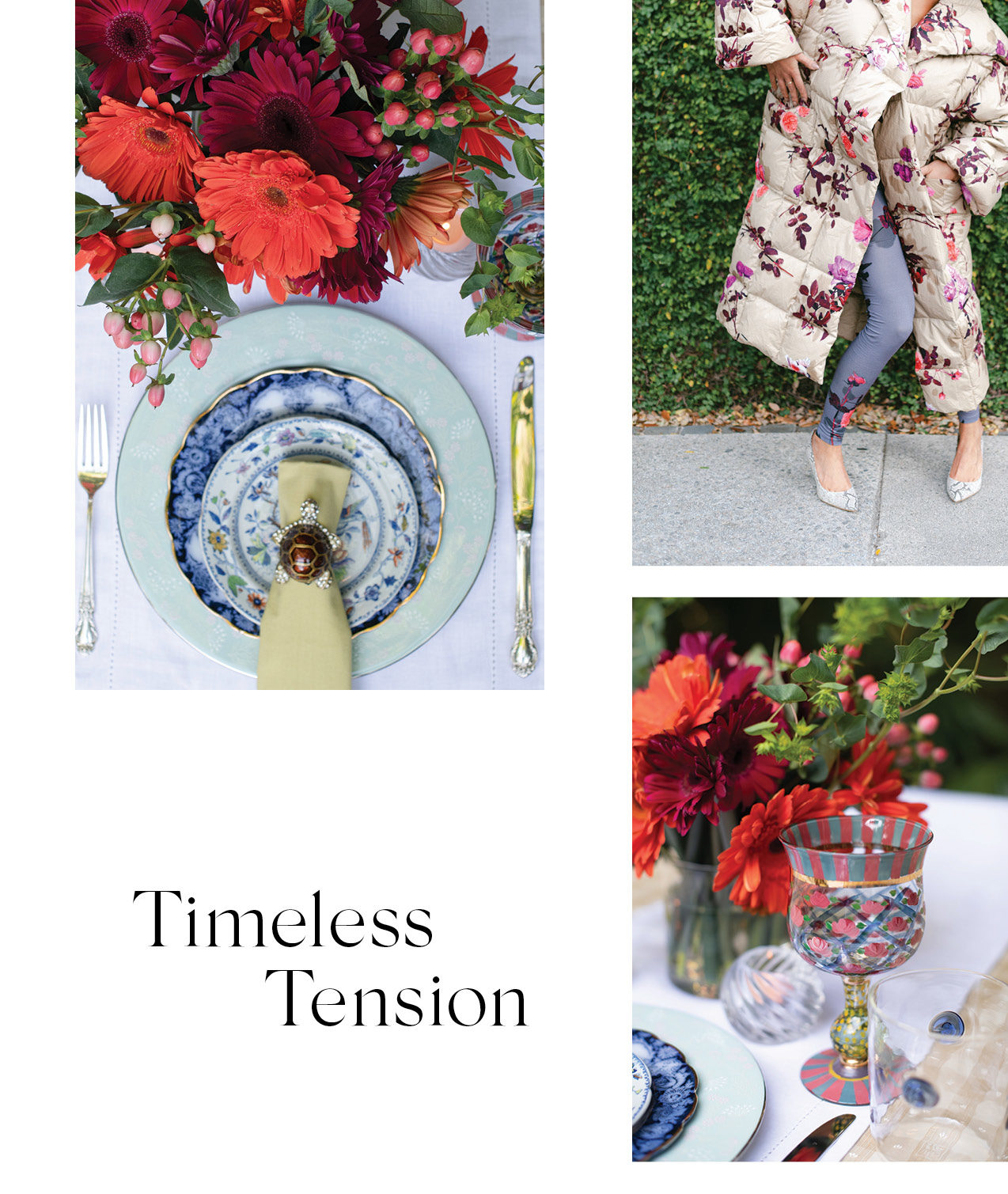 Through the marketing genius of De Beers, to the binary idea of marriage and forever, alongside media reaffirming timeless weddings in print, it’s no wonder why so many play it safe. The tension to reinvent one’s work year after year all-the-while creating timeless events, installations, arrangements, photographs, and gowns is something that feels limiting. I wanted to ask if color, bold print, pattern play, and textiles can compete in the arena of timelessness? Why are we so concerned now with what it will look like later? Is it our cultural programming to be stressed about our future? Can we be okay with the now, owning style much like the 60’s and 70’s did – what’s vogue today was vogue then? Why do so many want to erase today for tomorrow? -JR
Through the marketing genius of De Beers, to the binary idea of marriage and forever, alongside media reaffirming timeless weddings in print, it’s no wonder why so many play it safe. The tension to reinvent one’s work year after year all-the-while creating timeless events, installations, arrangements, photographs, and gowns is something that feels limiting. I wanted to ask if color, bold print, pattern play, and textiles can compete in the arena of timelessness? Why are we so concerned now with what it will look like later? Is it our cultural programming to be stressed about our future? Can we be okay with the now, owning style much like the 60’s and 70’s did – what’s vogue today was vogue then? Why do so many want to erase today for tomorrow? -JR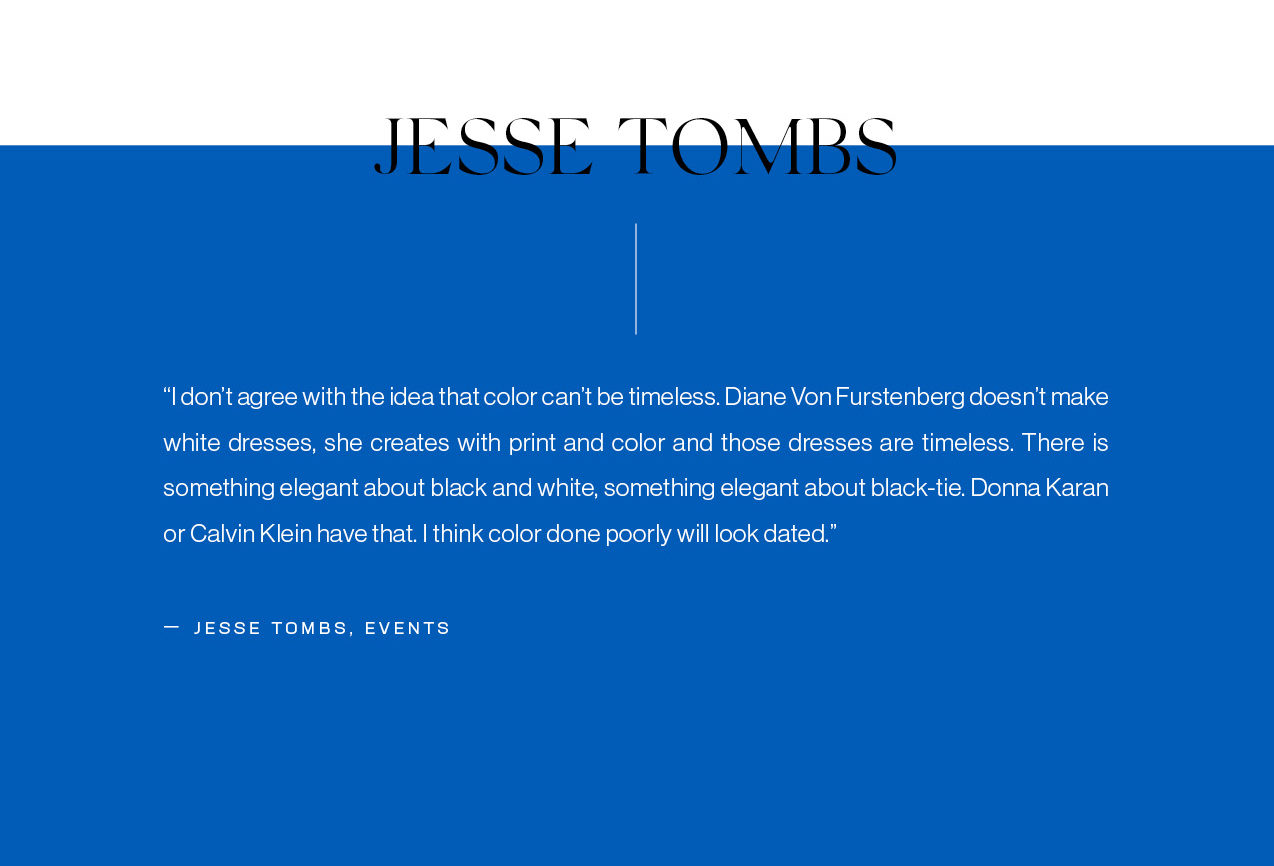
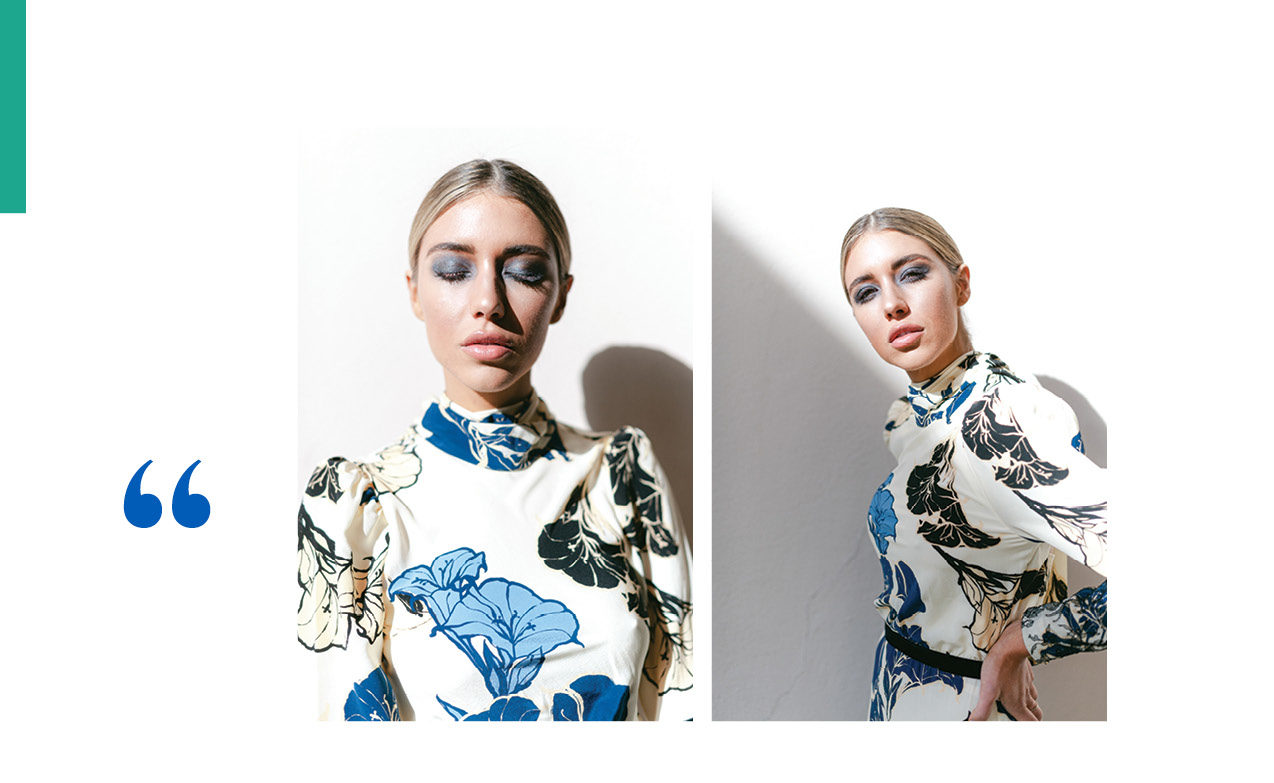
“Do you need timelessness for a wedding? The thing I say to everyone is when you look back at your wedding photographs twenty or thirty years from now, will you be happy? That’s all I need to know. Every one of us has a different experience of what timeless means to our emotions. If you’re going with color and not doing what everyone else is doing you have to trust your gut, you have to be brave as well as confident. If you can be those things and proceed with color then you’re going to be really happy you did twenty years from now because you made that strong choice. If you’re unsure or scared of it absolutely run the other way. I’m not sure timeless is about color, it’s about style and knowing where the line is between clever and eye-rolling.”
– David Beahm, Experiences
“Our clients want to do whatever makes sense for them and they are completely happy to forgo tradition entirely. They want their events to be timeless. I think part of that is actually ignoring any and all trends and that’s how you produce something that is truly timeless.”
– Alison Laesser-Keck, Alison + Bryan Destinations
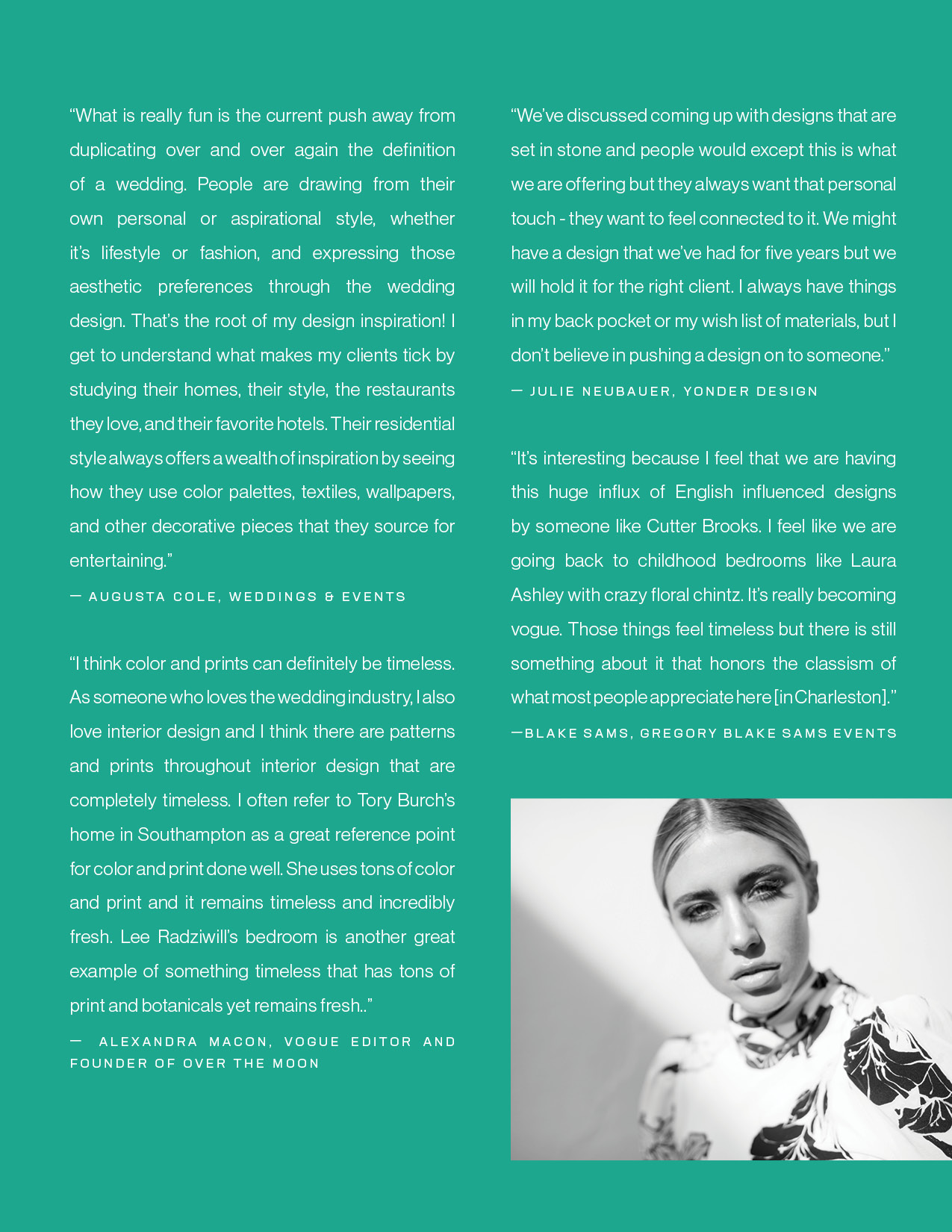
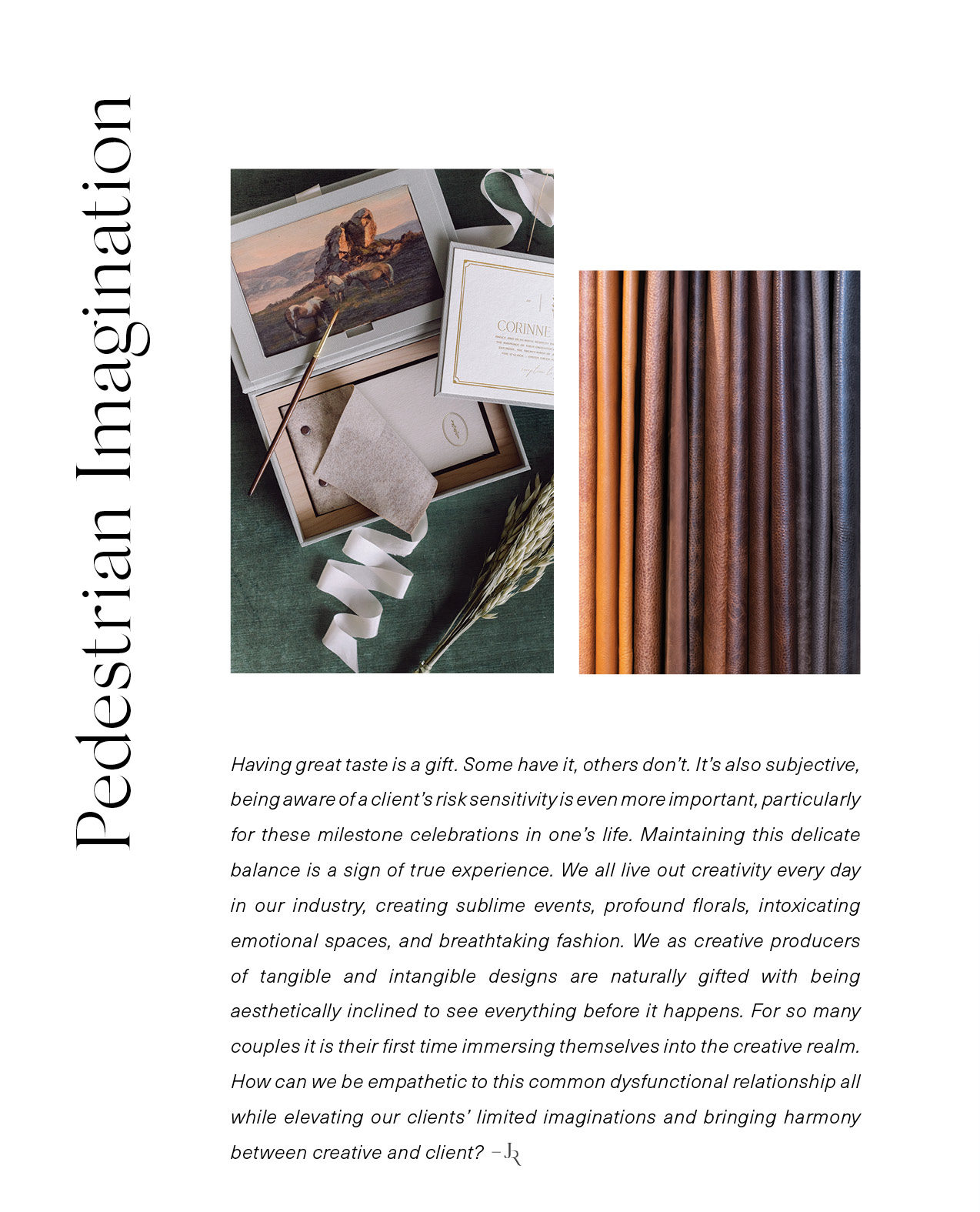
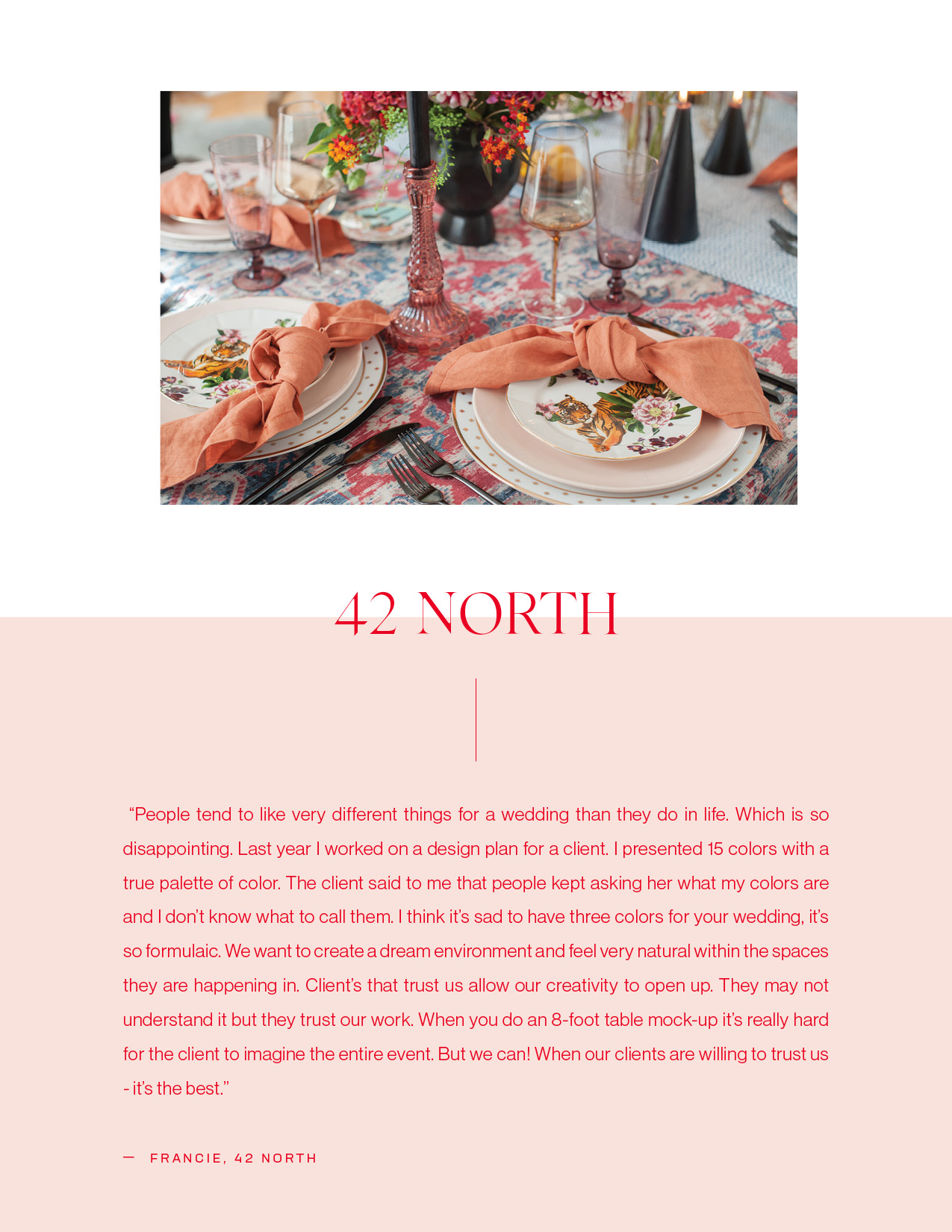
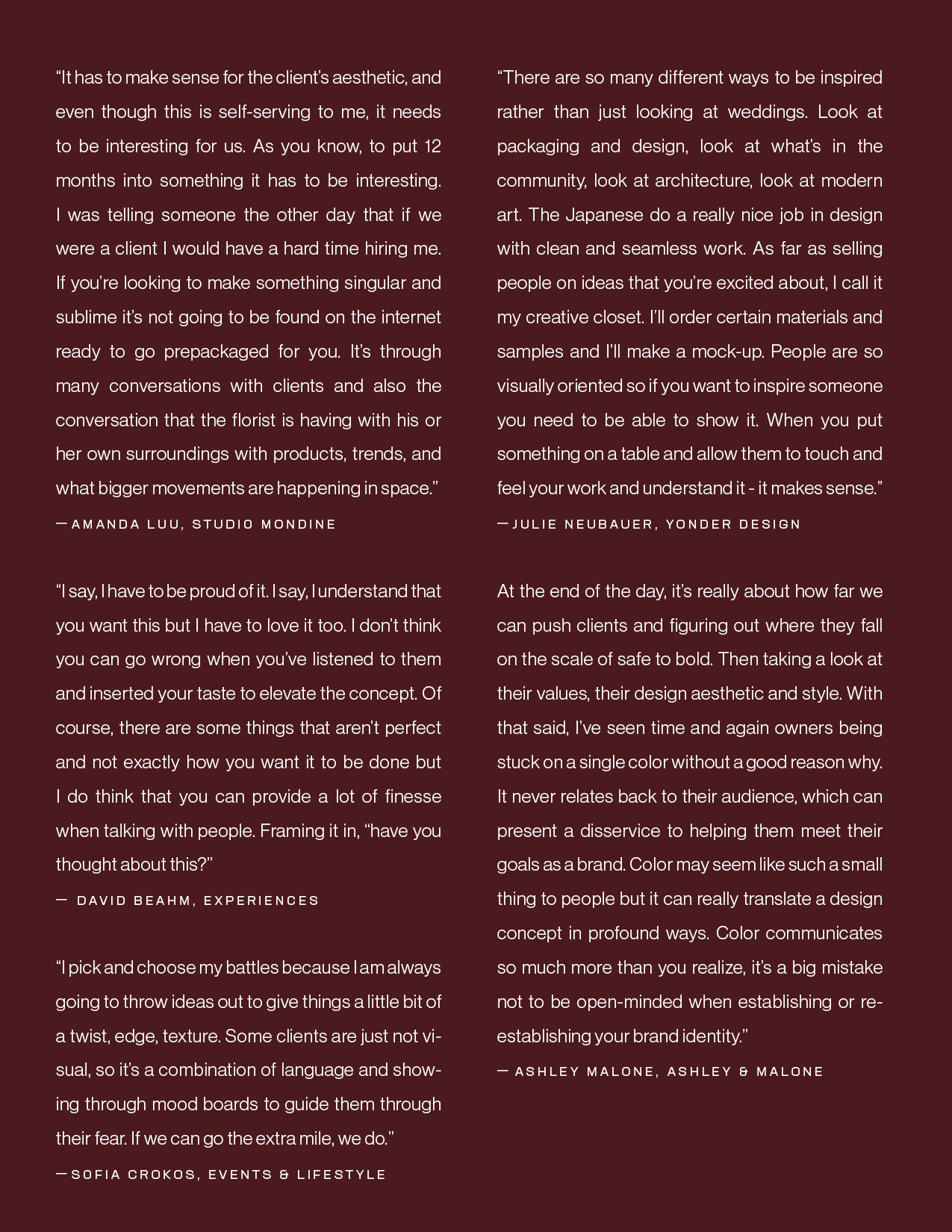
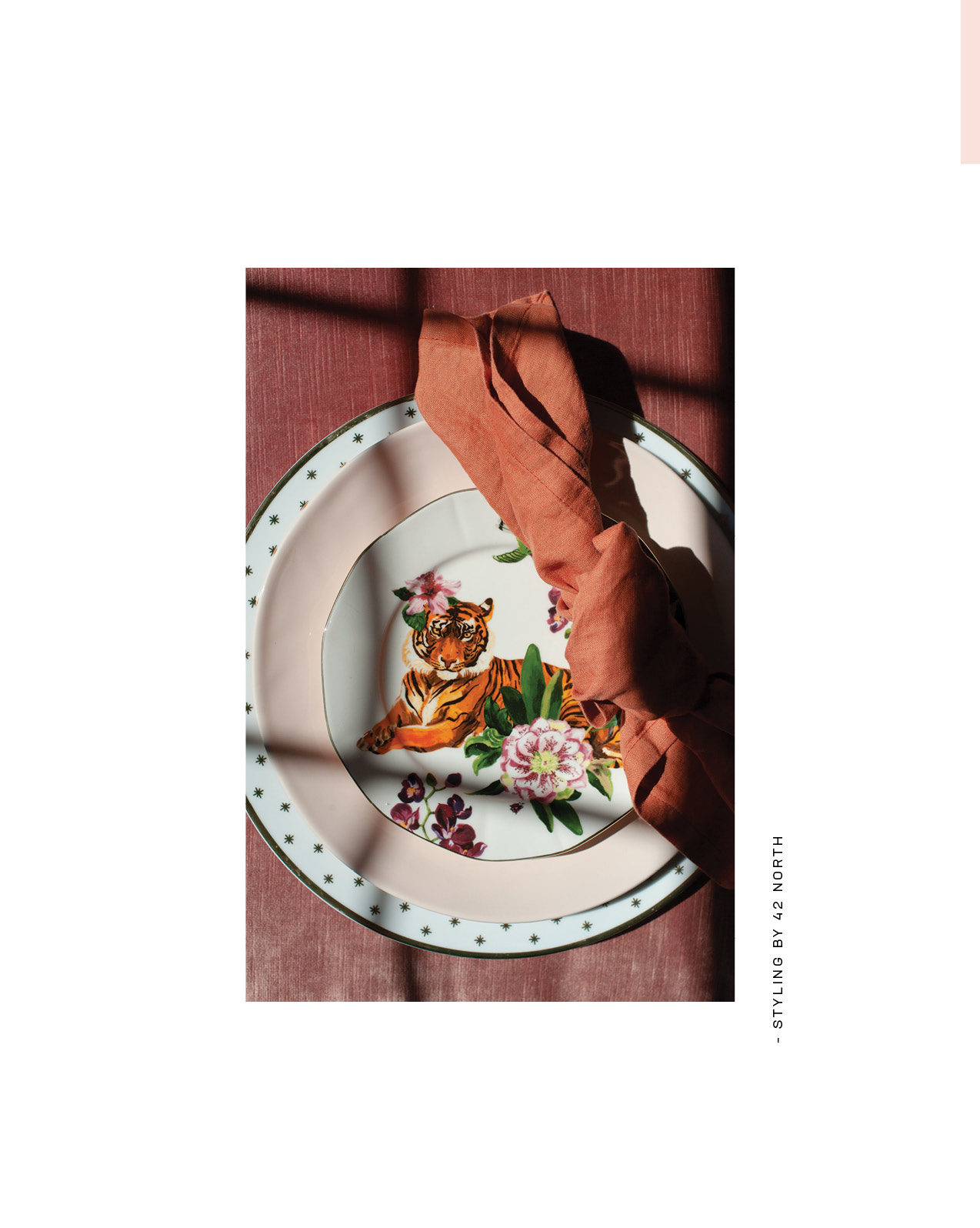
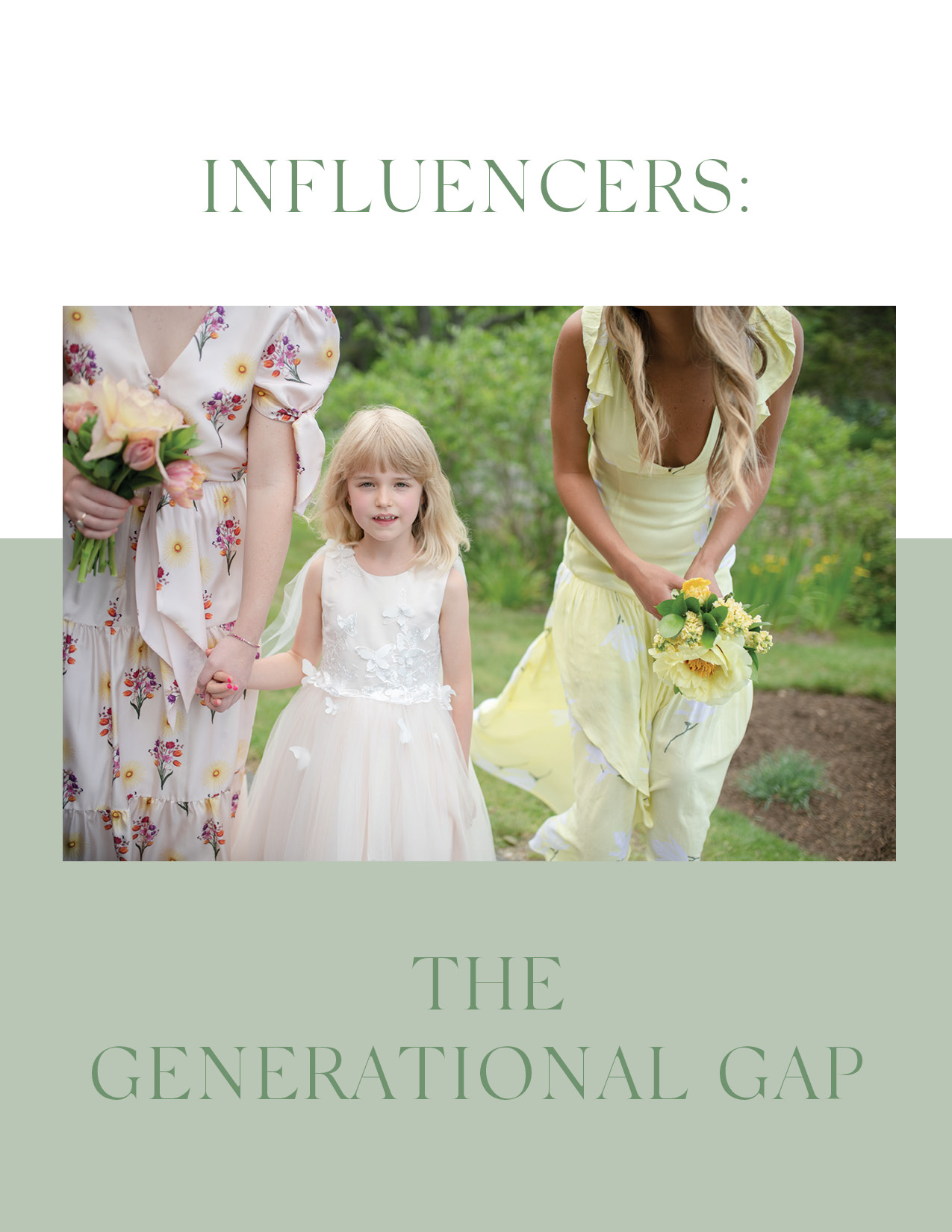
Navigating the tension that comes between a modern-day bride and the families that surround her can be a challenge. This dynamic range of input can seep into every element of the design process. Generational expectations, rituals, and traditions need to be respected all while ensuring all parties are served. How does one mitigate this generational conundrum while producing work that satisfies not only the client but their creative souls? Do we have to choose between the old and the new? Or can we have both? -JR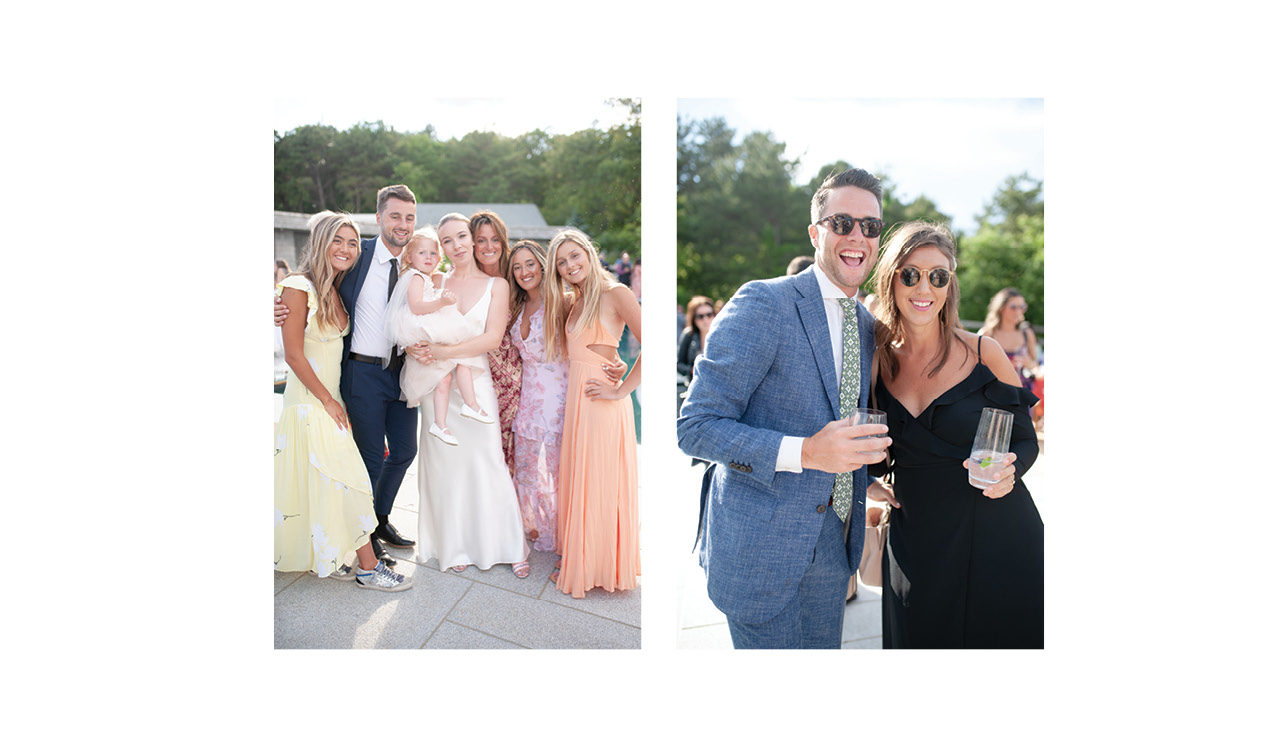
“Sometimes the mother never had the big dreamy wedding that she wanted but she’s living vicariously through her daughter. Where does the daughter and her partner fit in? I see a lot of that. When it is controlled financially by the parents, there is a lot of piping through third parties that creates tension. The parents may think it’s not the right way, it’s not what their friends did, it’s not what they have seen in the media – they are hung up on the idea of what people are going to say if they opt for the unconventional route.”
– Sofia Crokos, Events & Lifestyle
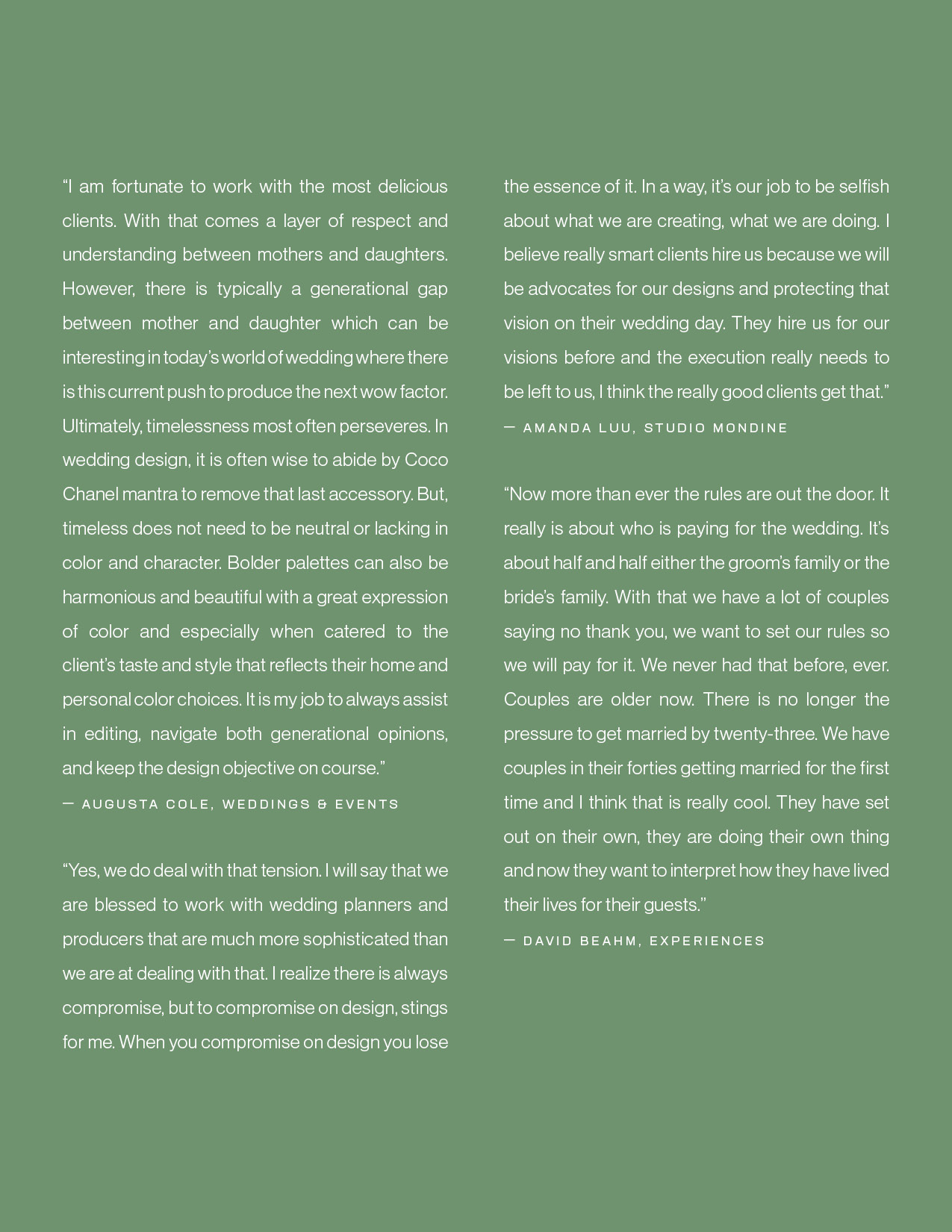
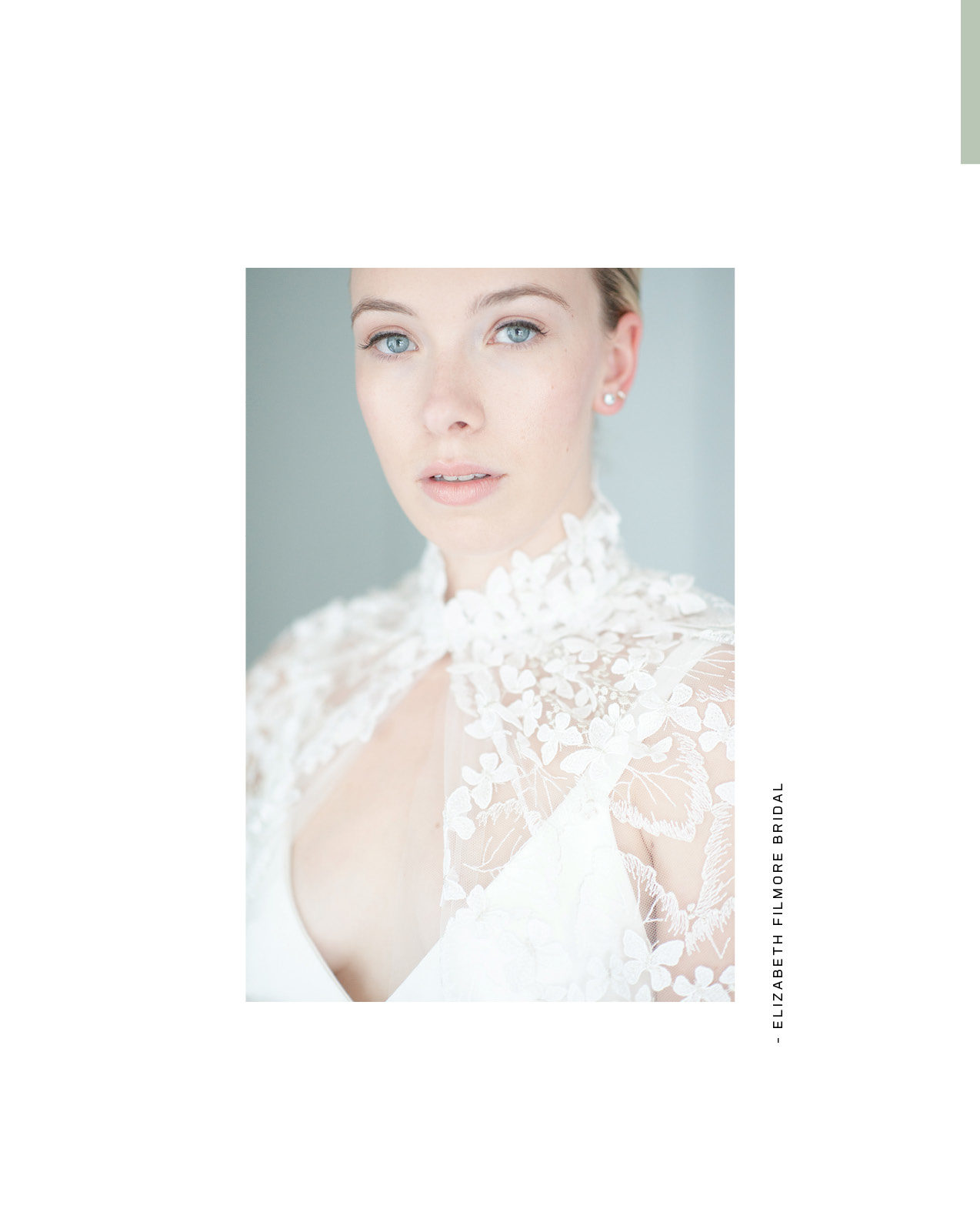
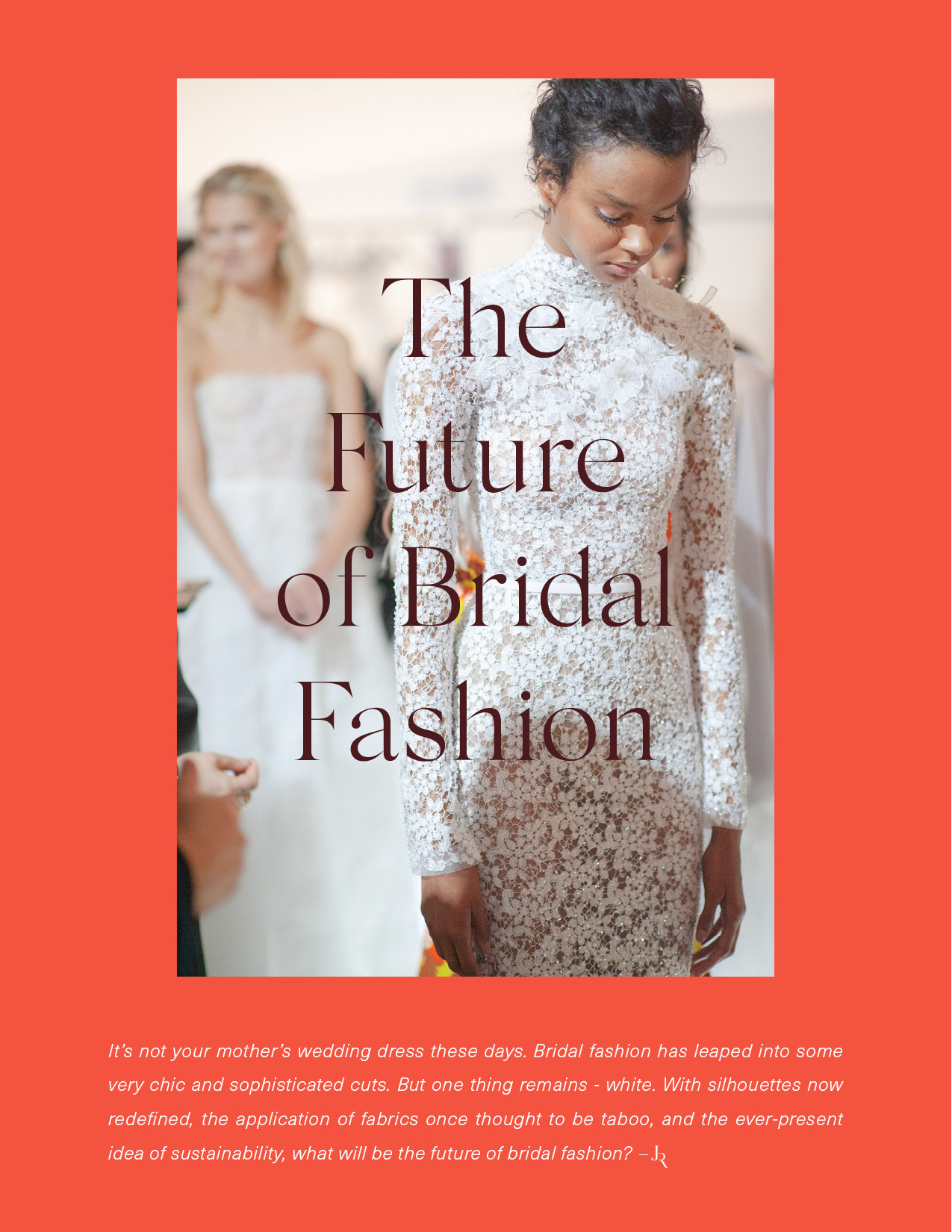
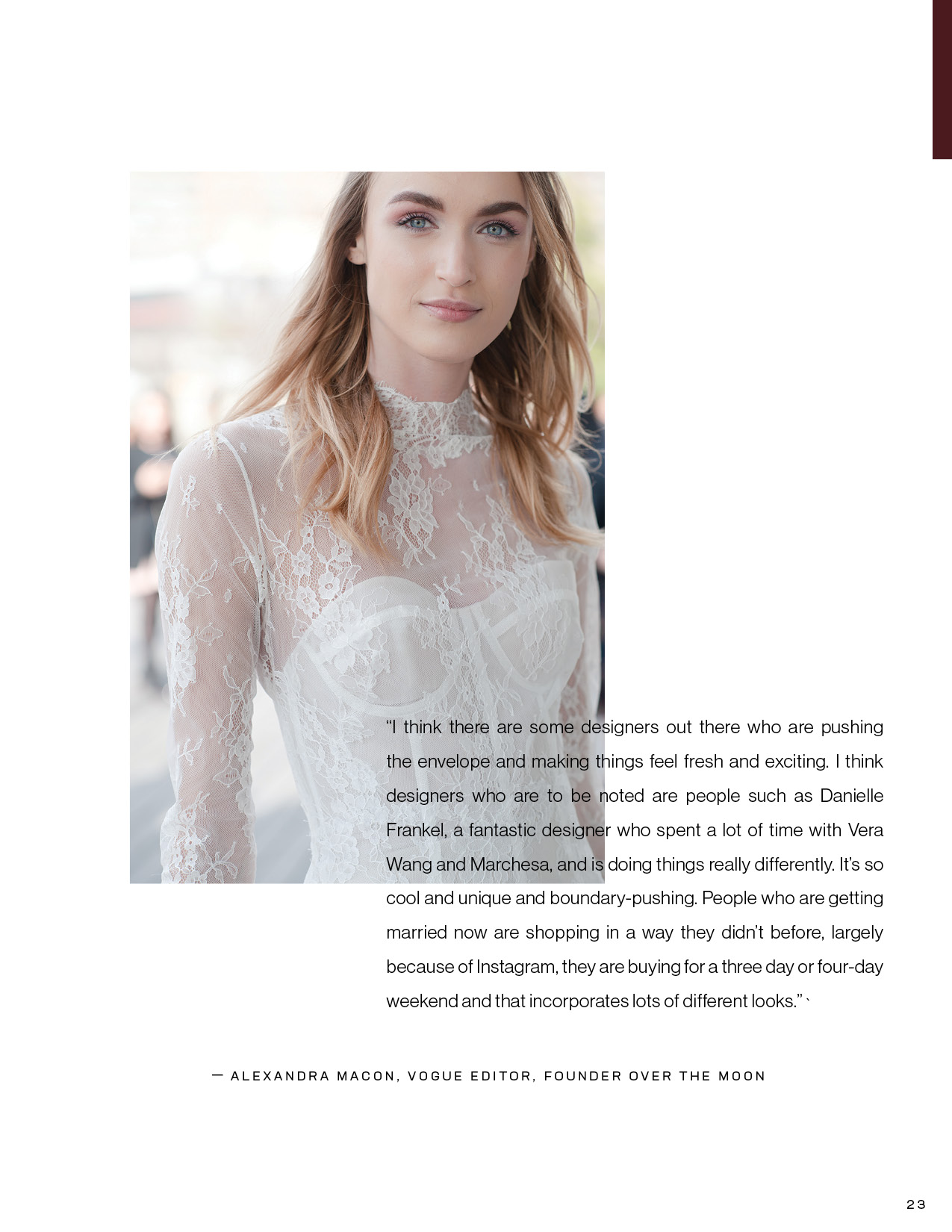
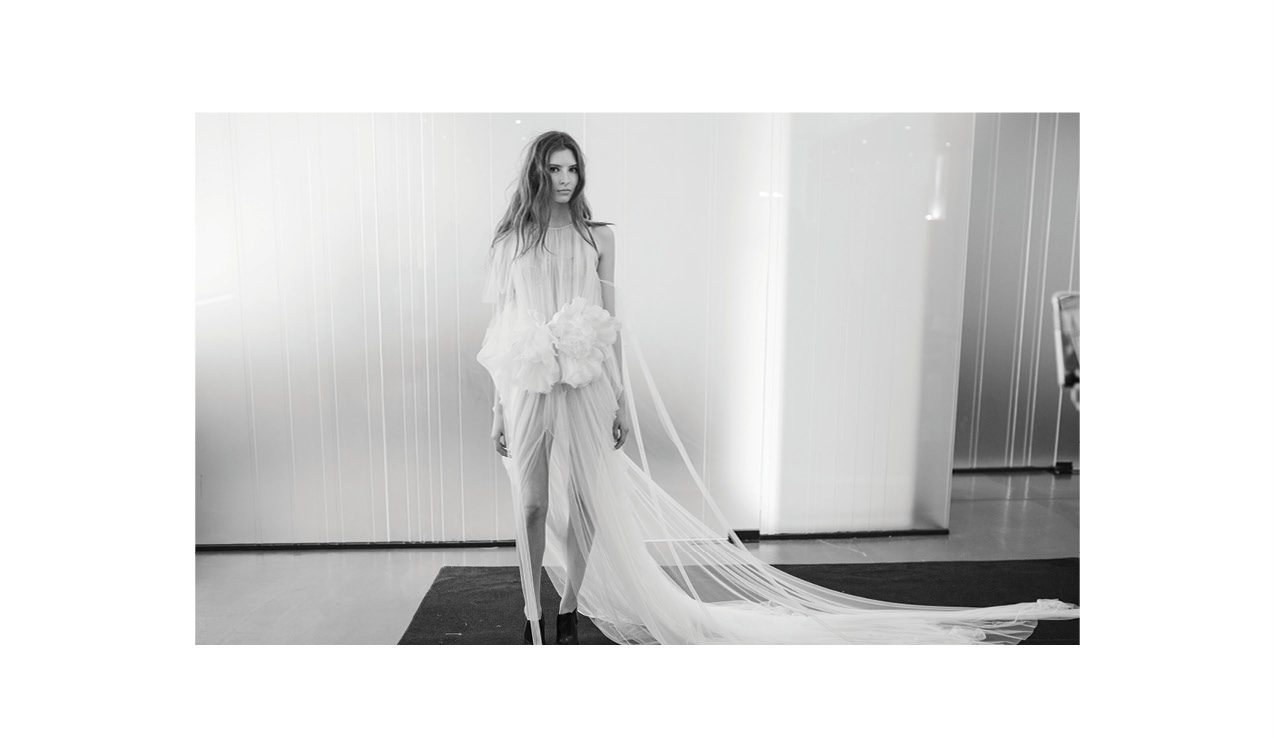
“The dress is really informative to us. When we dress shop with our brides it’s incredibly helpful for many reasons but we get to see how they react emotionally to things. It helps us figure out how we are going to work with them and it becomes euphoric. Then sometimes we get an email of the dress they’ve chosen and were like “oh okay” then we say let’s design a different wedding now.”
– David Beahm, Experiences
“There are very few opportunities for women to wear a long white dress and it’s so ingrained in us that white dresses are wedding dresses. I think you’re definitely going to see some different looks whether it has a print on your wedding dress or a kind of pattern in color. I don’t think brides will get rid of a white wedding dress altogether.”
– Alison Laesser-Keck, Alison + Bryan Destinations
“People see their wedding as an opportunity for an Instagram moment and they need to have the wardrobe to accompany that. Mira Zwillinger is a fantastic designer who is doing a lot of things that women want right now. It’s beautiful lace, it’s beautiful embroidery and embellishments done in a sophisticated way. It’s form-flattering and romantic. There is a lot of drama but it’s not cheesy.”
– Alexandra Macon, VOGUE editor, Founder Over The Moon
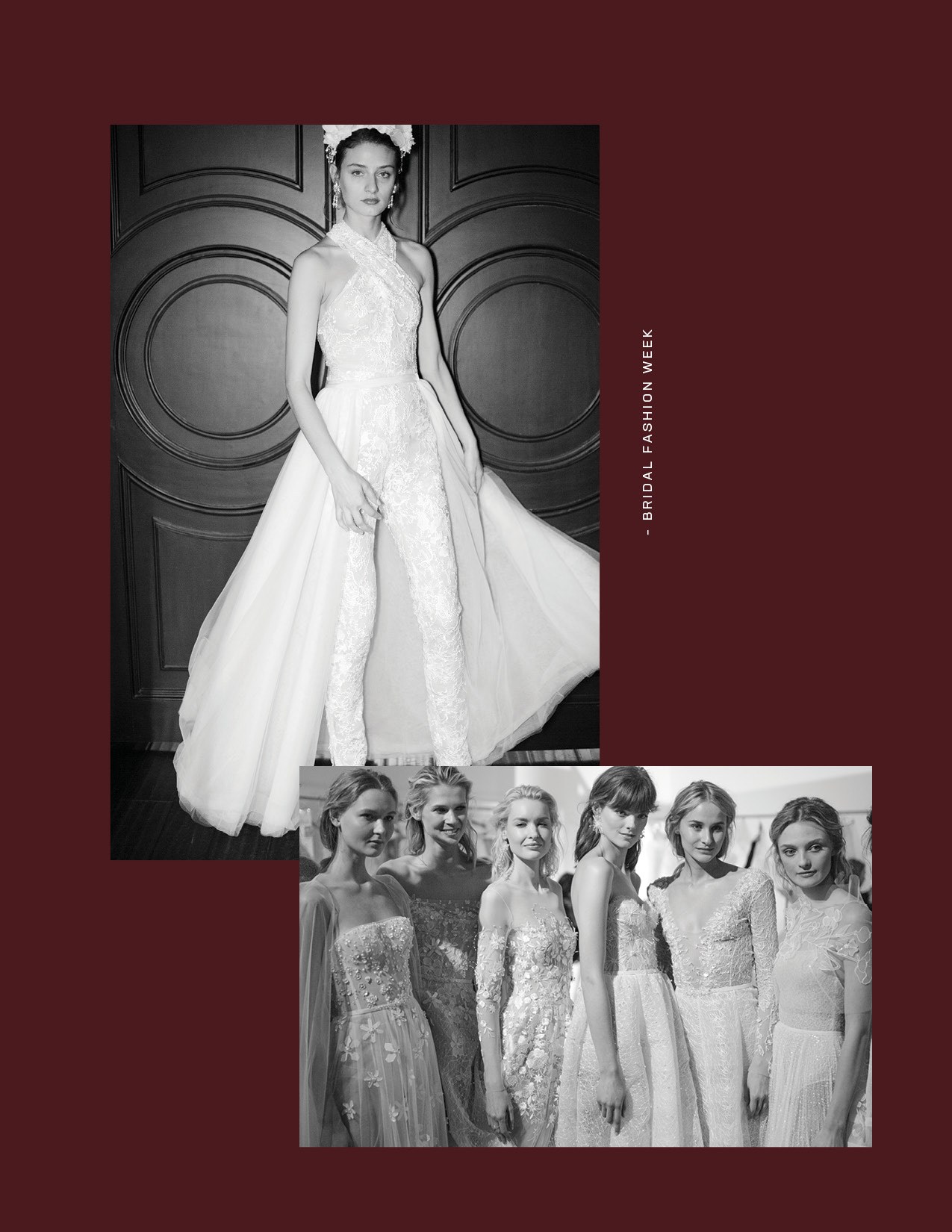
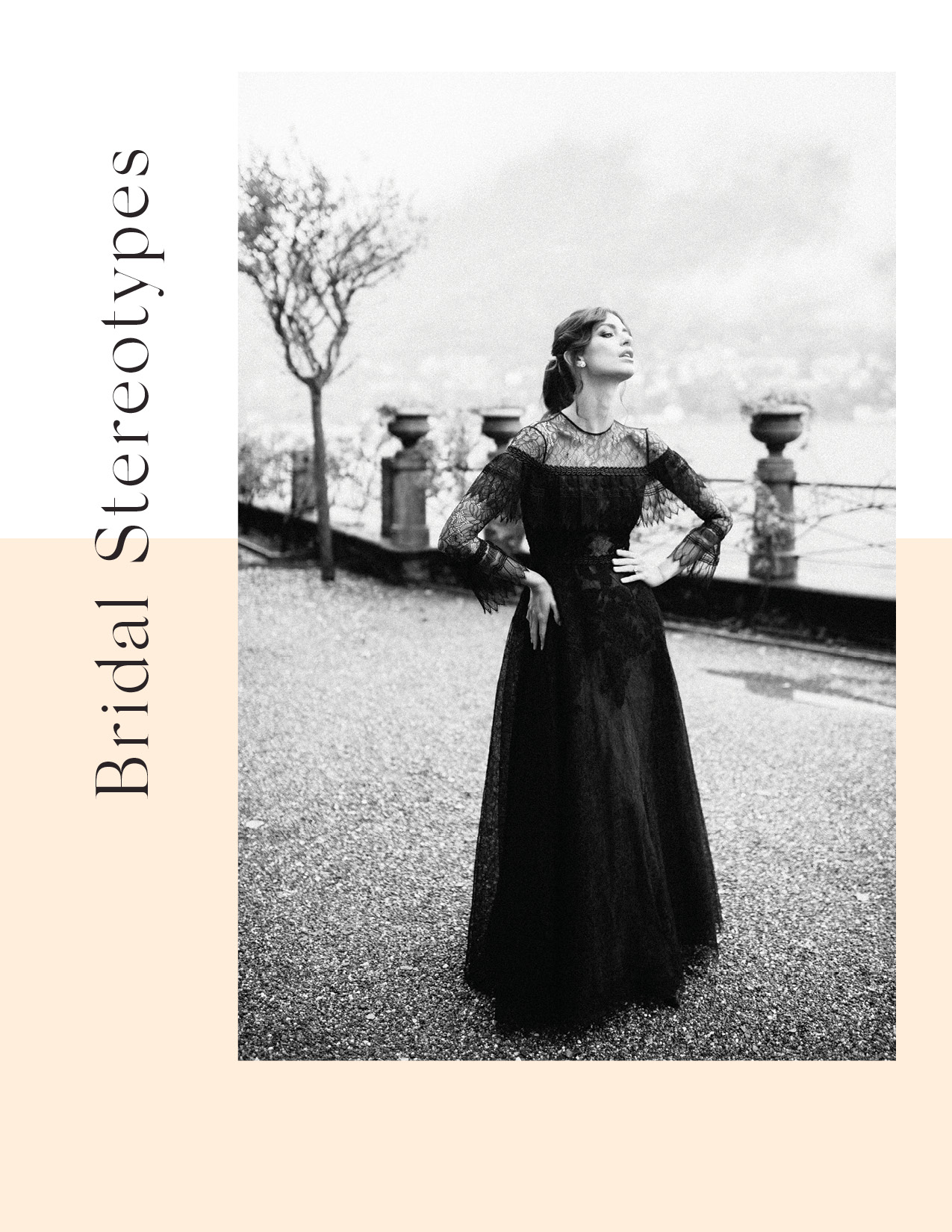
I have had the pleasure of shooting collections during NYBFW for Vera Wang, Carolina Herrera, Danielle Frankel, Naeem Khan, Reem Acra, Lela Rose, and Mira Zwillinger among others. In a sea of white, sometimes it’s tough to discern one from the next. In her Spring 2019 collection, Vera Wang explored the use of color in a way that nearly had me buckling at the knees. Will we see more designers embrace color? How can we honor a time-honored aesthetic while staying forward-thinking to the changing styles of modern-day brides? What’s the best way to create a cohesive fashion narrative from engagement through wedding. -JR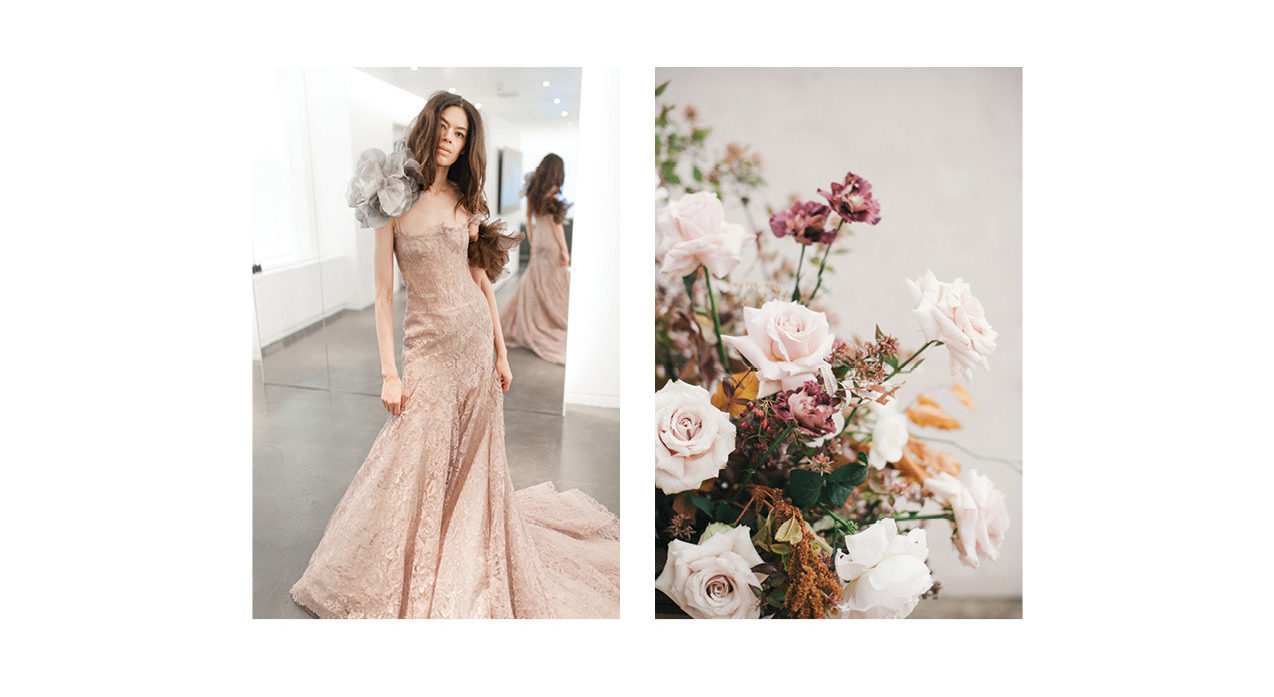
“I think a luxury bride pays attention to interior design trends and ready-to-wear trends. They are aware of certain trendy colors of the season and they are afraid that if they embrace color on their wedding day it’s going to date their wedding photos. For a lot of brides it’s the safer bet – or for the lack of a better word – boring. They go with whites, blushes, golds, and greenery because color is a bold choice right now and it’s hard to do color in a subtle way. If you do color you have to do color. I wish people did do color!”
– Gabrielle Hurwitz, Bridal Stylist
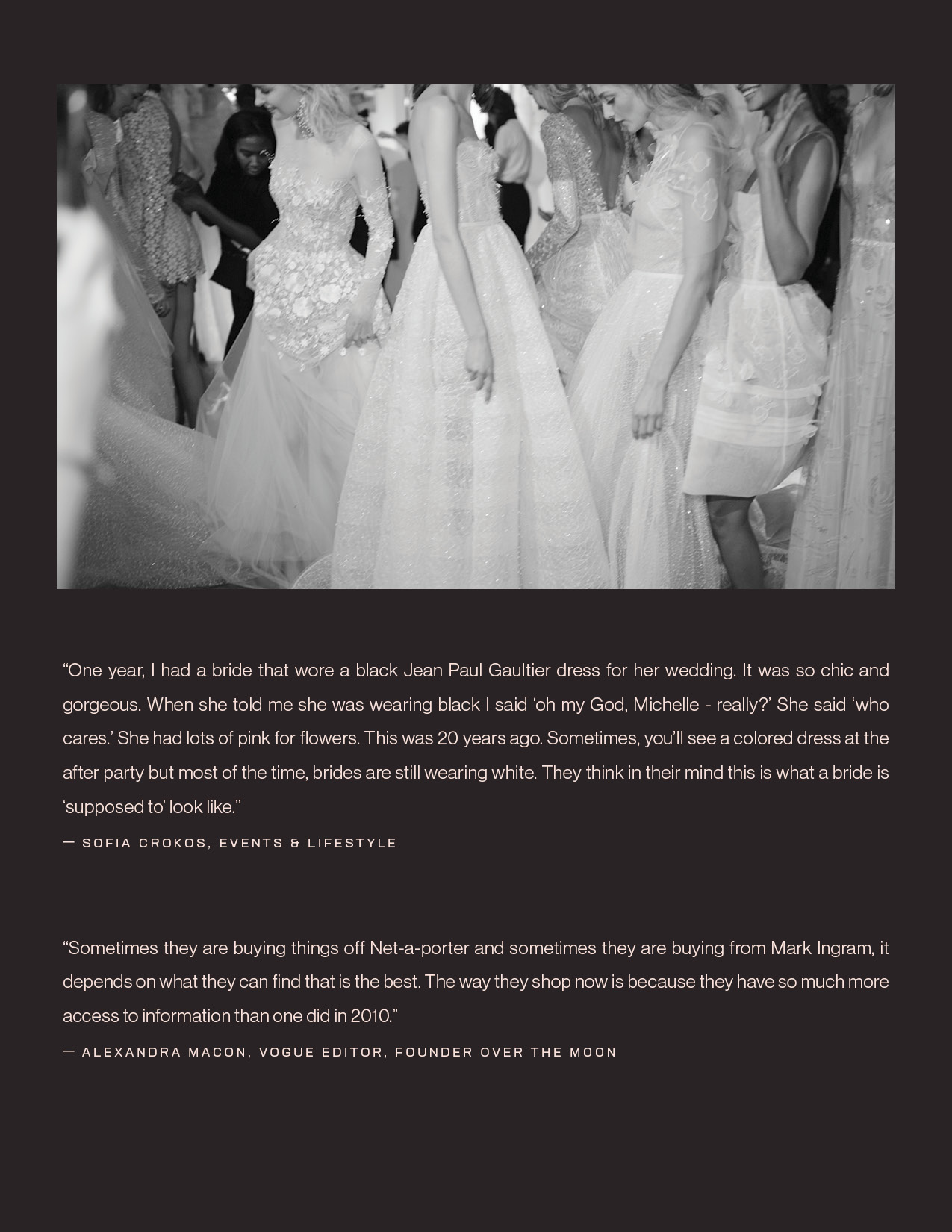
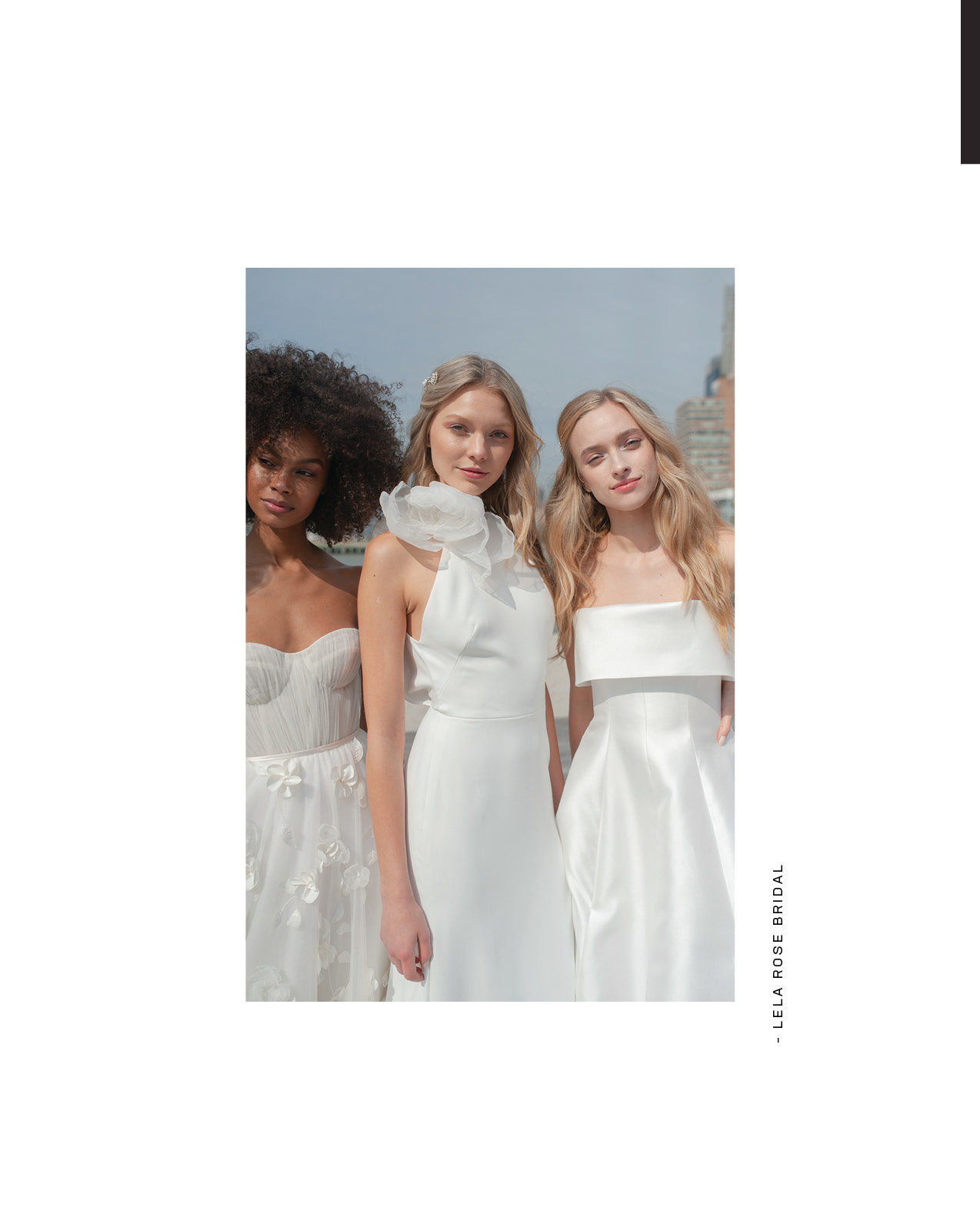
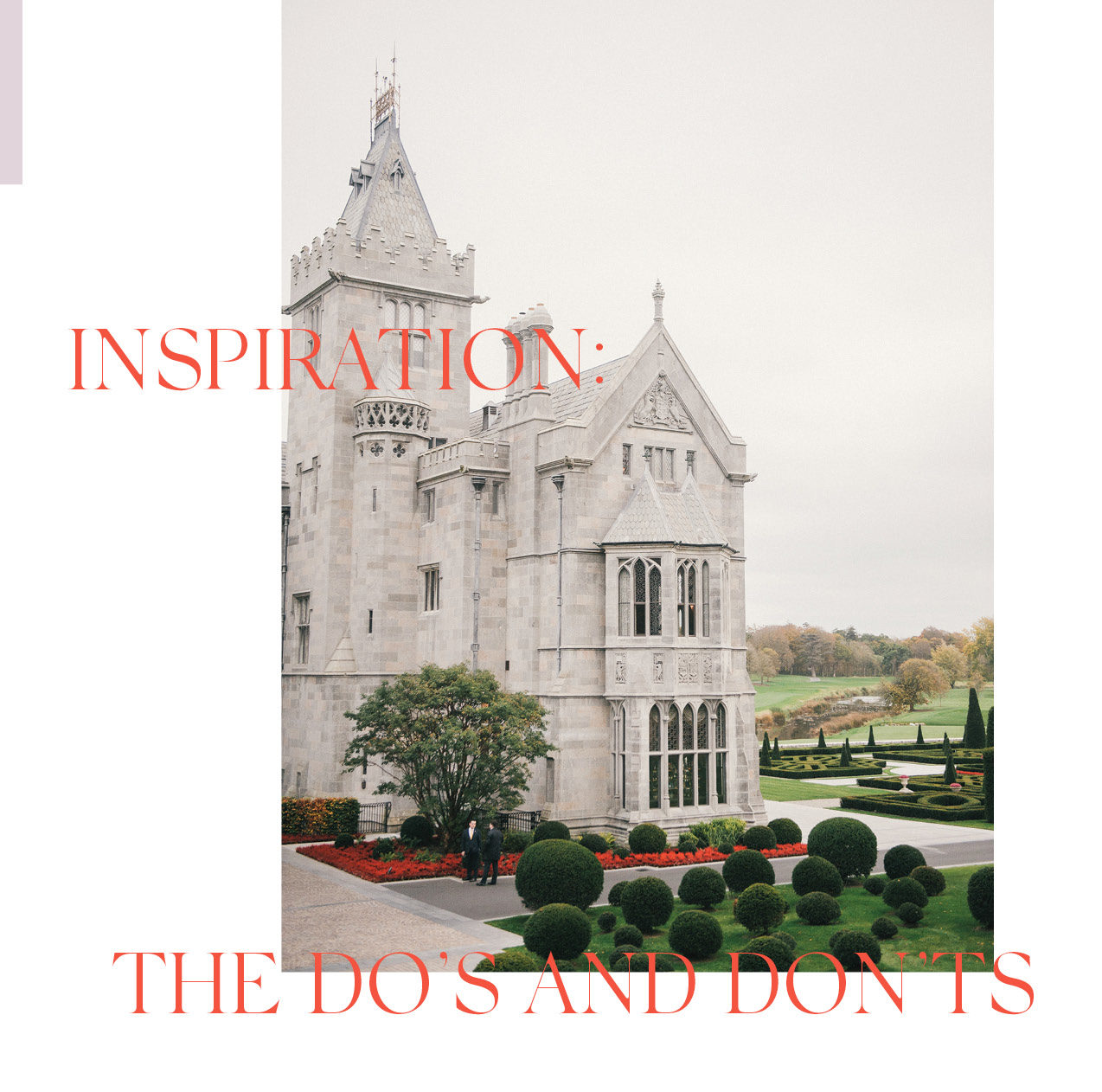
We have endless roads to follow when it comes to artistic exploration – and where a design ultimately lands is a culmination of so many intertwined avenues. Within this section, our contributors have unveiled these incredible maps – from cultural experiences and travel to art history and literature to more modern channels like digital and social media. How has technology changed the event design process, and what can we expect to see in the next evolution of this industry? -JR
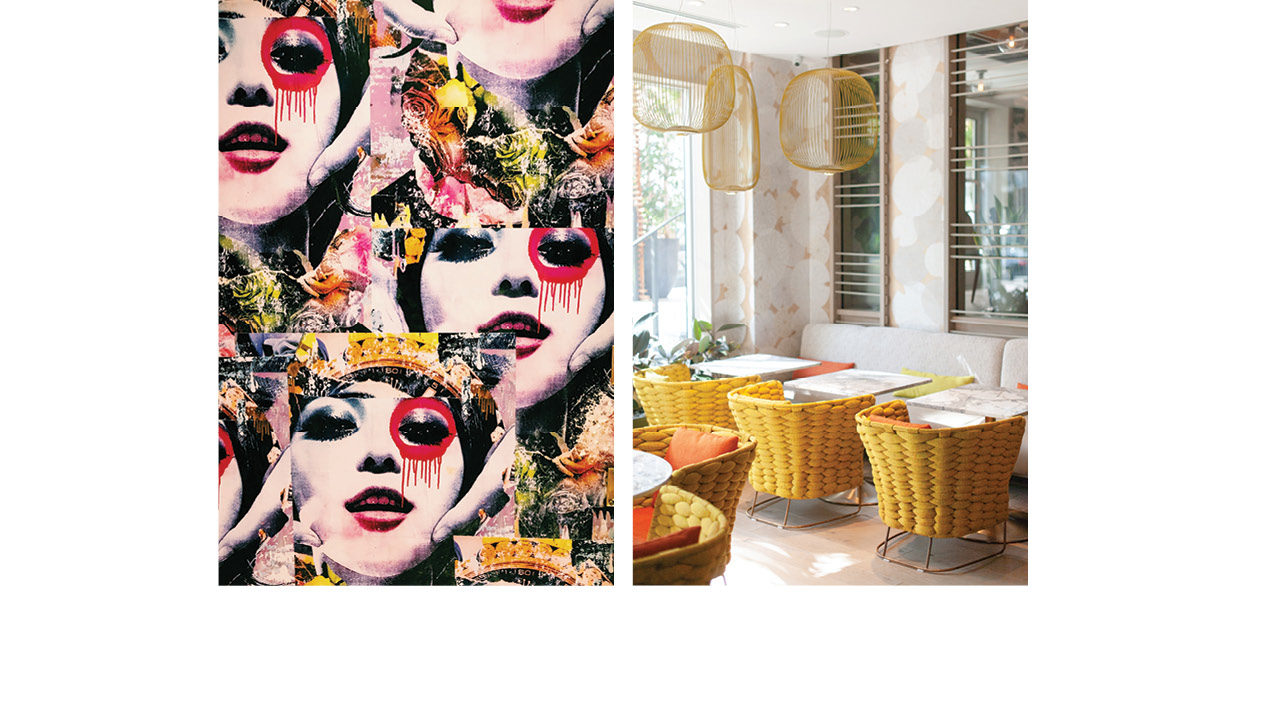
“The reason why we do events that have color in them and have interesting palettes is because we’re not getting inspiration from things that have been done before. We are getting inspiration from our client’s art collection or a hotel they stayed in or and an album cover that they love. In fact, we tell our clients not to look at Pinterest or Instagram. What you see is a reflection of that designer’s aesthetic and not a reflection of who you are as a client. So, let’s find something that really interests you. I always ask my clients, ‘what is the story that you want to tell?’ A lot of the clients that we work with maybe don’t know at first, they are not creative. So we have to work with them to figure out what is that story. What’s the feeling we want guests to walk away feeling? What’s the takeaway after the wedding? What it really comes down to is that most of our clients want their guests to walk away saying wow that was so them. So we are trying to figure out through details an authentic way to continually remind guests of them throughout the event. This is their wedding, this is a detail that speaks to them as a couple, this is something that authentically reflects them. That’s the most specific thing we work towards with a client and their guests,”
– Jesse Tombs, Events
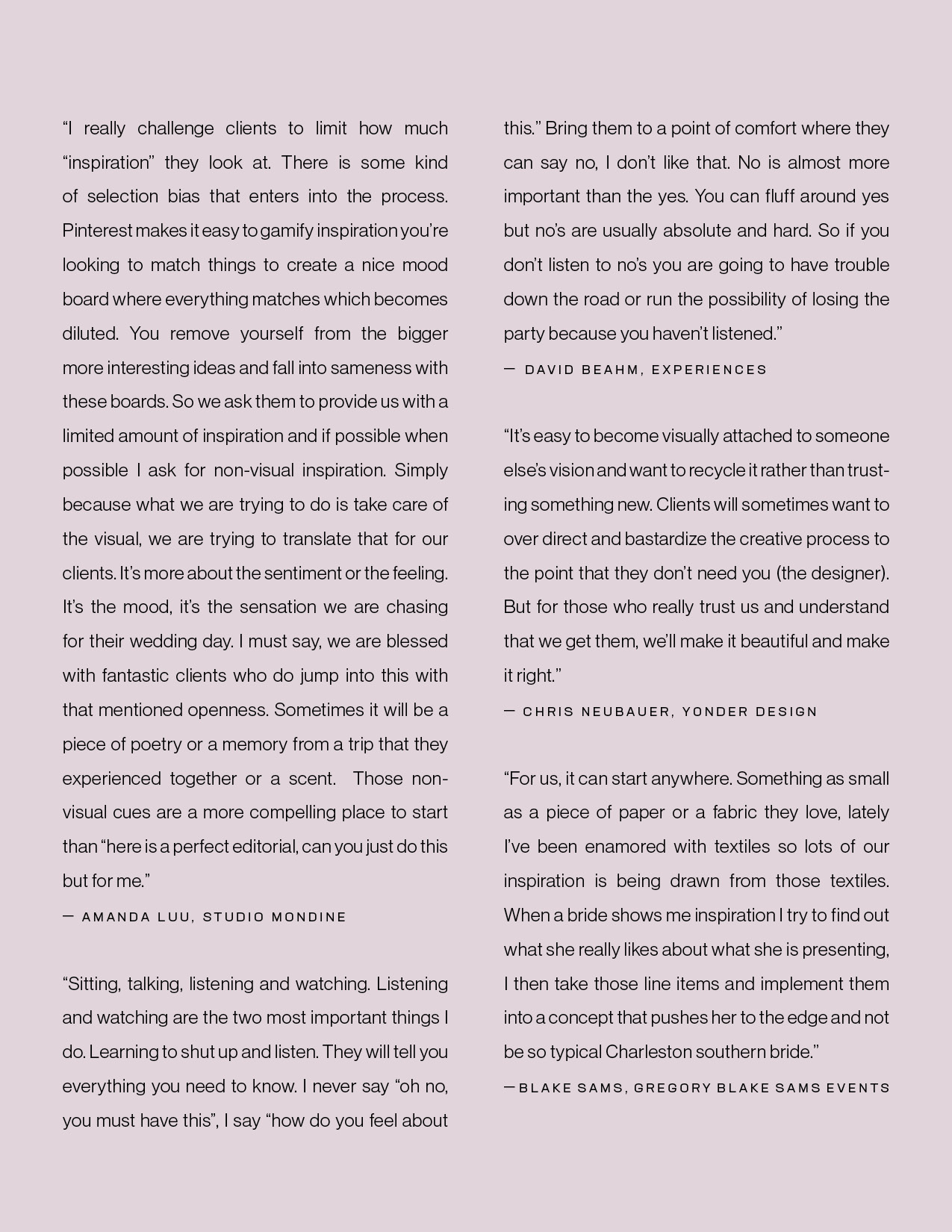
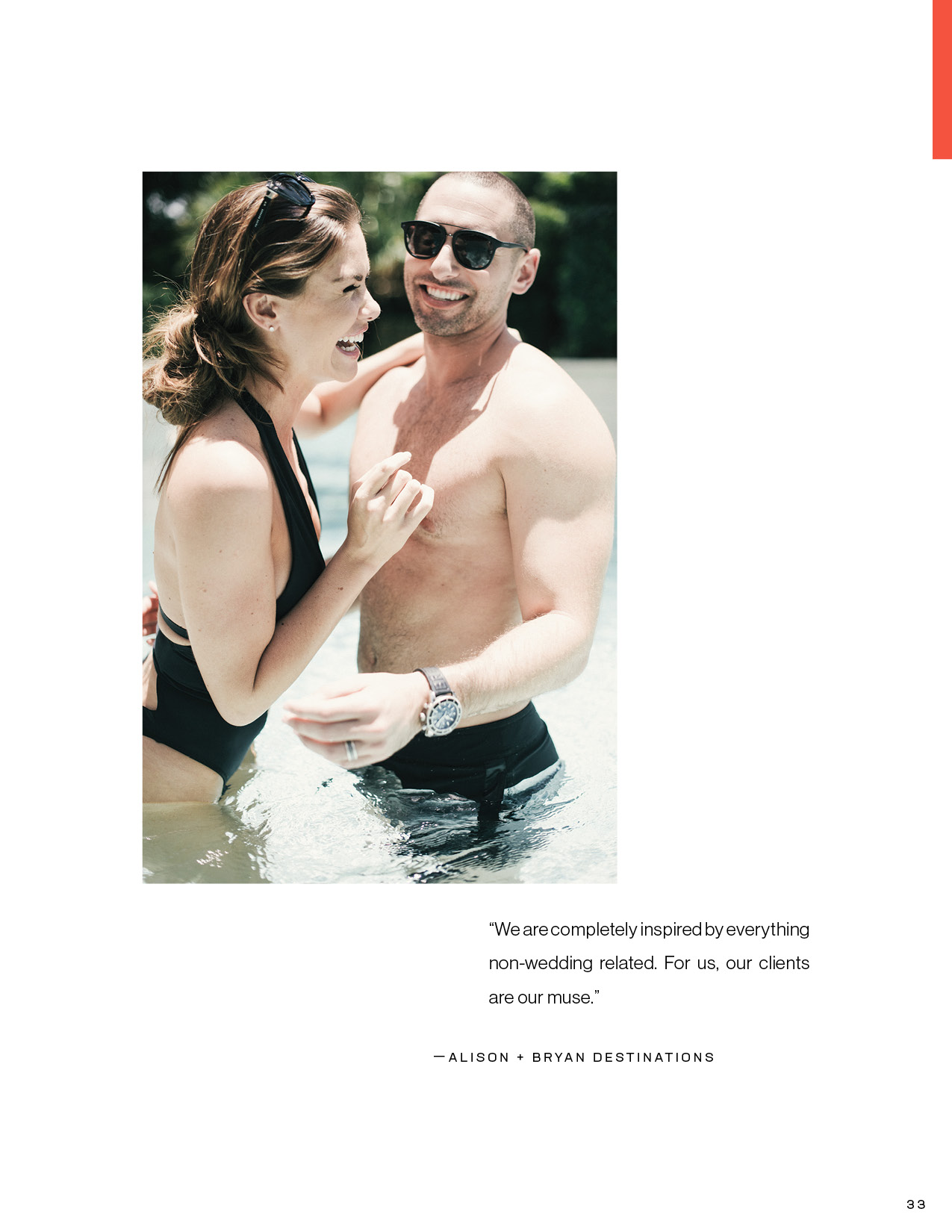
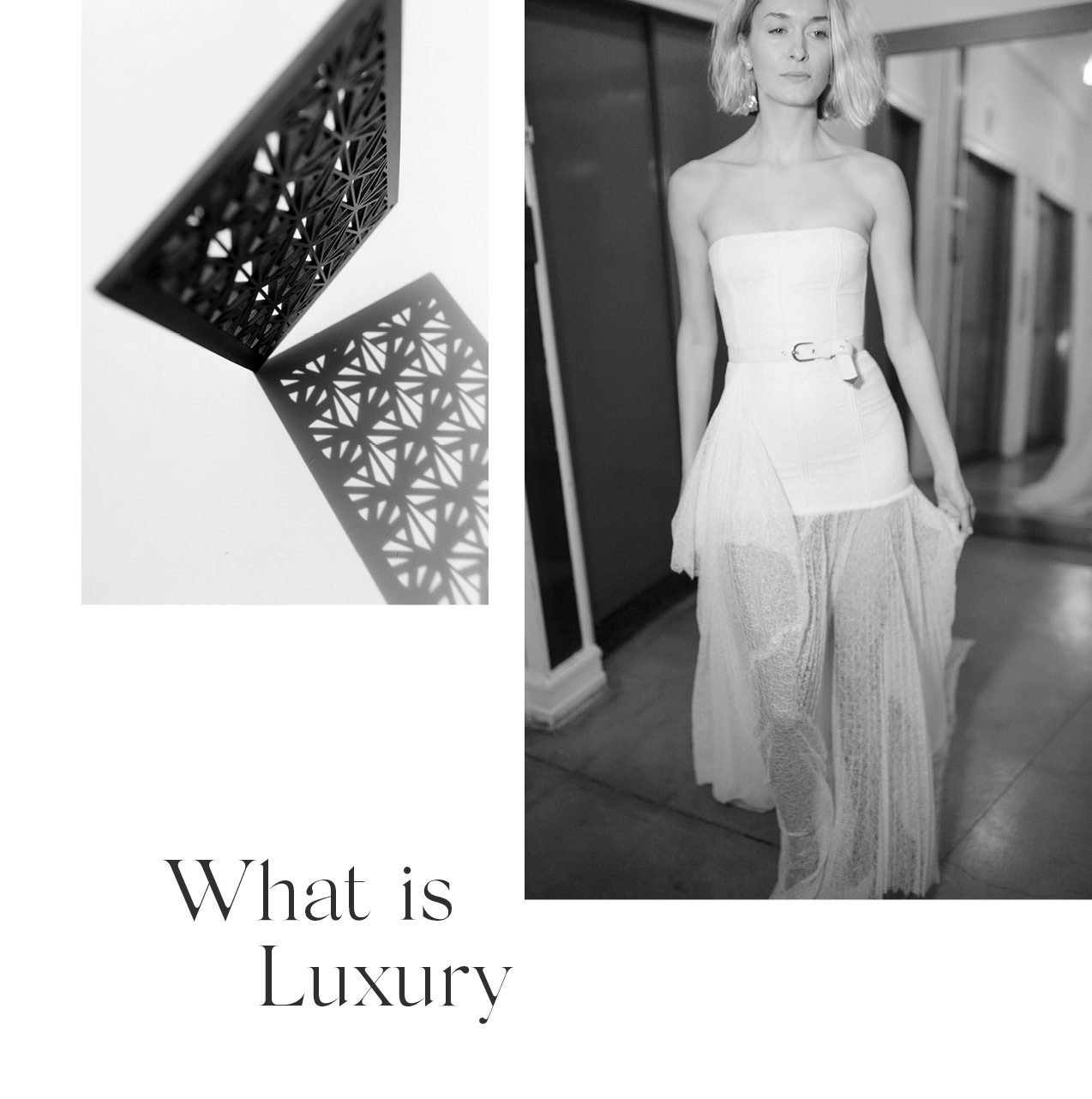
Throughout my conversations with some of our country’s top luxury event creatives, the question I could not leave behind was the very idea of luxury. What does luxury mean to those who create, provide, and produce for events that are thought to be luxurious to the rest of the world? -JR
“Understated elegance, our sense of luxury is nothing with a logo per se, nothing that is outlandish, nothing that is gaudy or showy. Tasteful, simple, clean – just because something is minimal doesn’t mean it is cheap. Just because something is expensive doesn’t mean it has to be garish. Everything we do tends to be understated. You can create luxury without expense. It’s a feeling of quality when you have something in your hand.”
– Chris Neubauer, Yonder Design
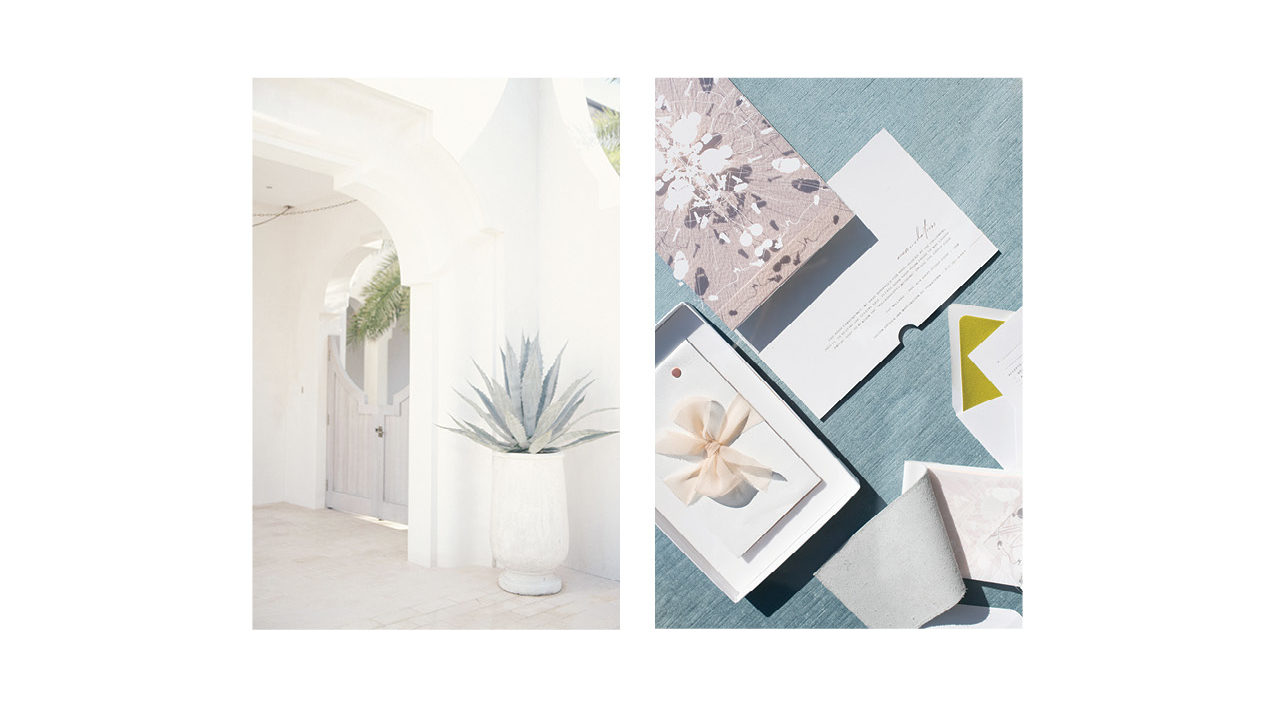
“There is an effortlessness in luxury. When you’re experiencing luxury it should be blissful and joyful, you should be transported from everyday concerns or troubles. I see it in photography, brides are wanting that candid capture of effortless joy. That feels luxurious for them. With design, it should be approachable and sumptuous and layered in an intoxicating way. Not jarring, not flashy, not aggressive.”
– Augusta Cole, Weddings & Events
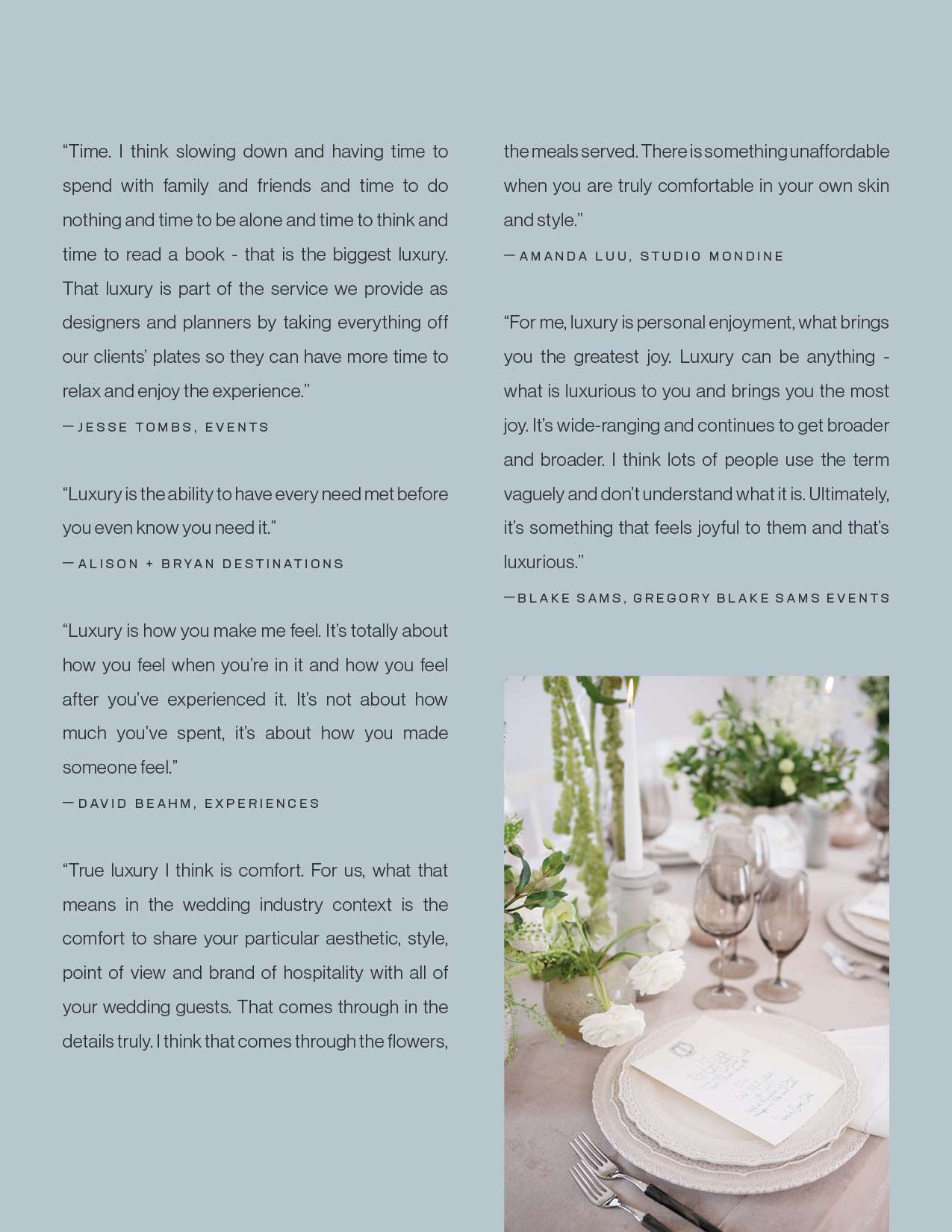
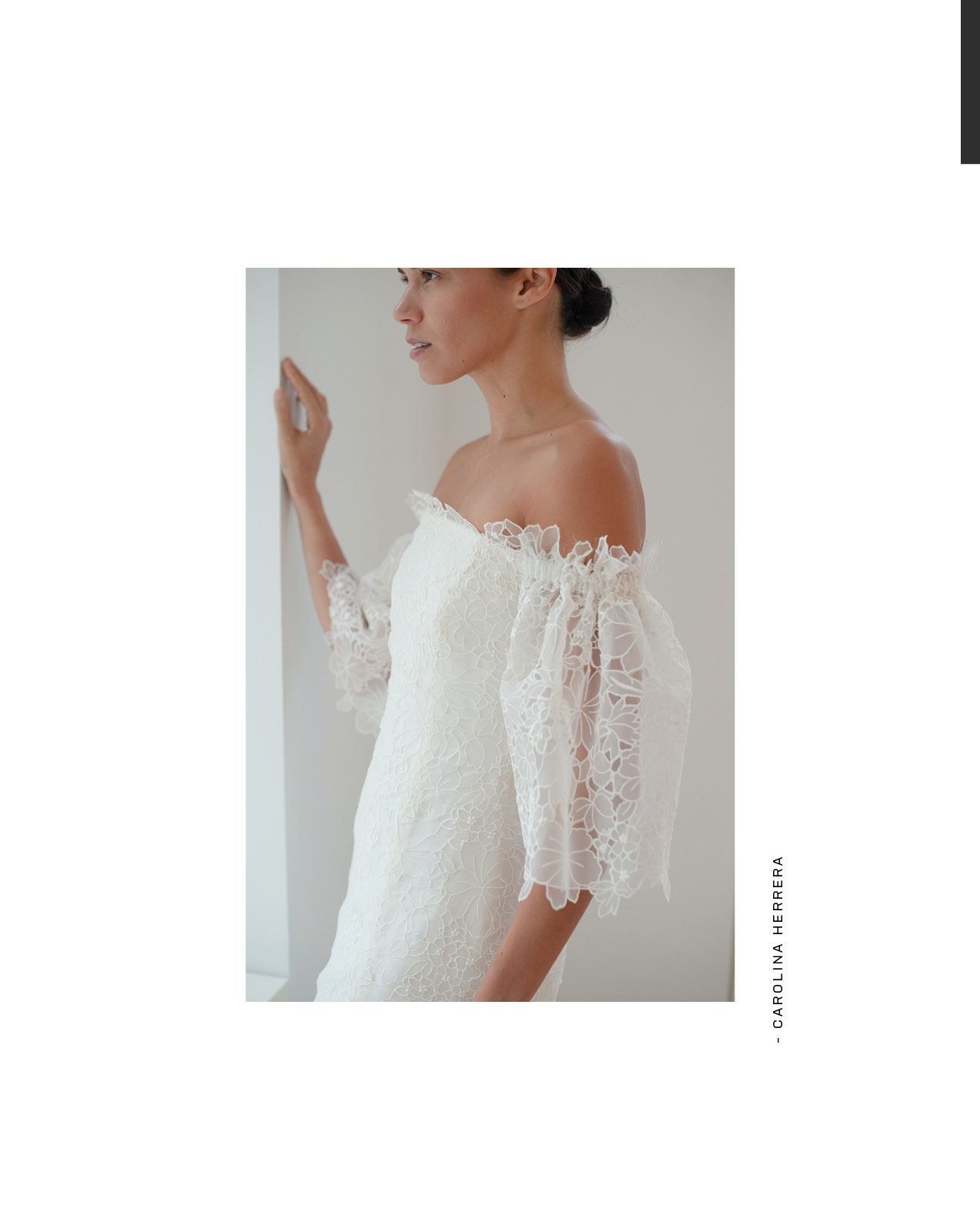
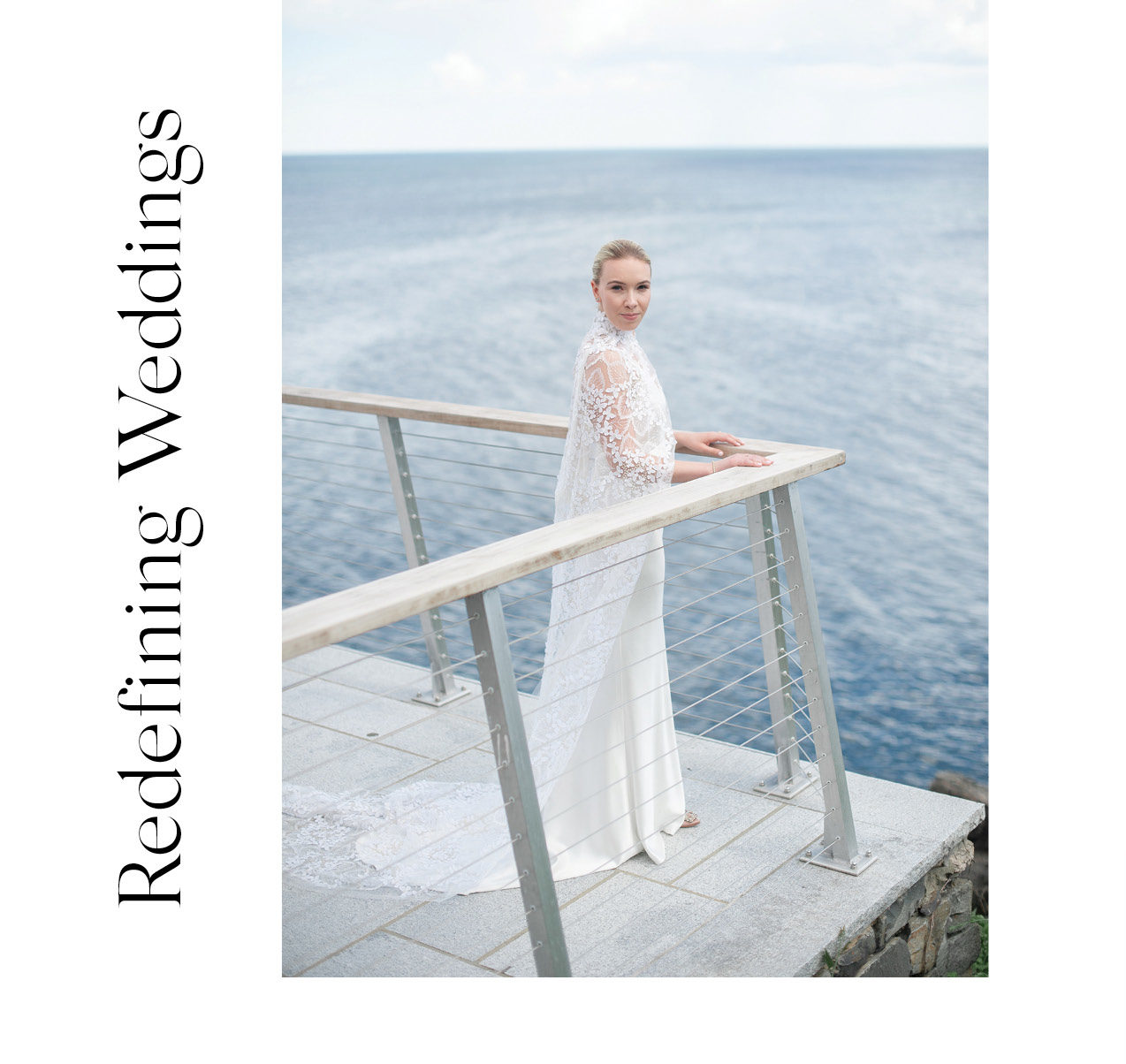
Cultural norms are changing by the day and with that so are many traditions and expectations of what weddings should be. Bridal fashion has become more inclusive. Destination weddings continue to grow in popularity for their appeal to transport guests to another world. Intimate dinners, unique locations, and elopements allow for even more personalization. More of our clients are integrated into the way they kick off their union and we are so thankful for this shift. Are we heading into a new age of event design, and what is leading this revolution? -JR
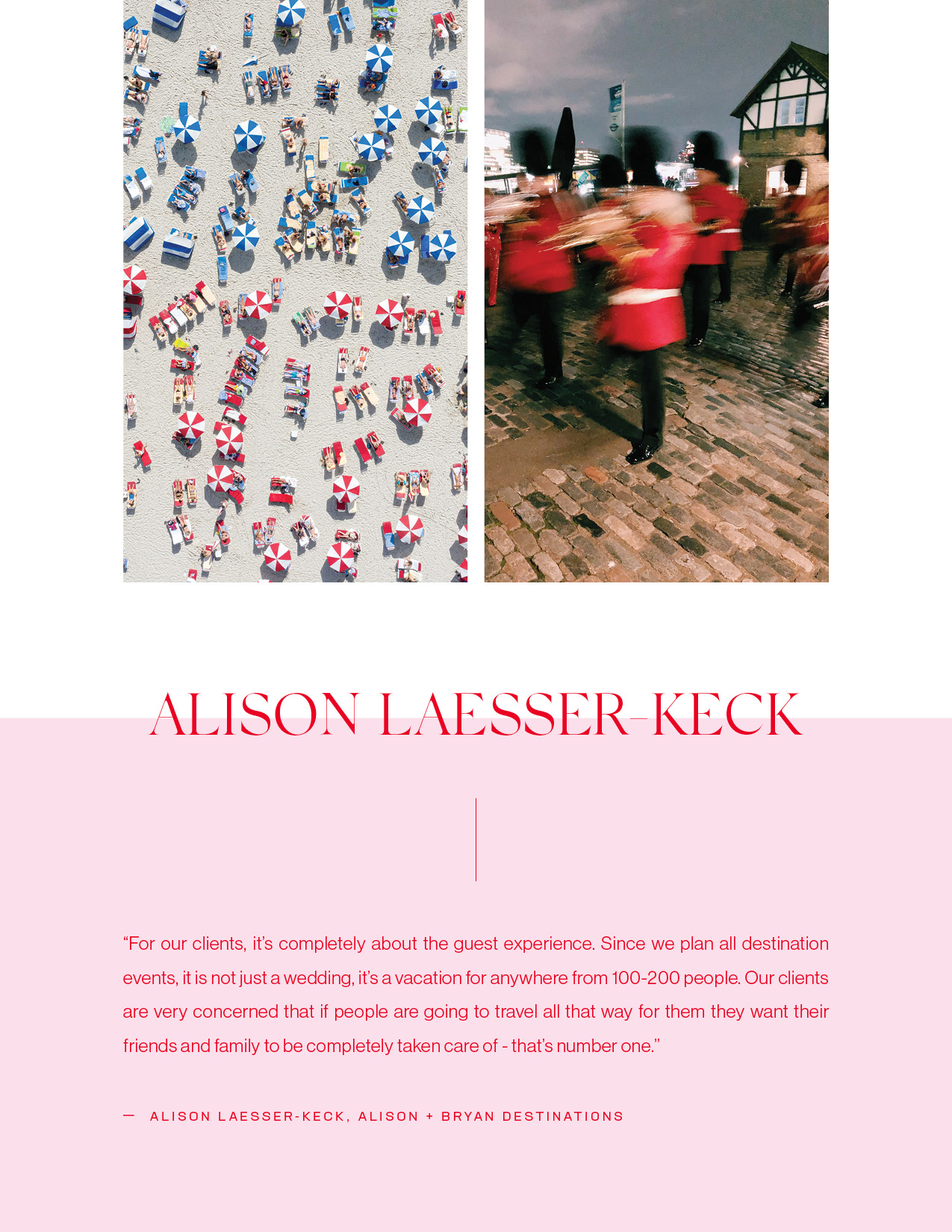
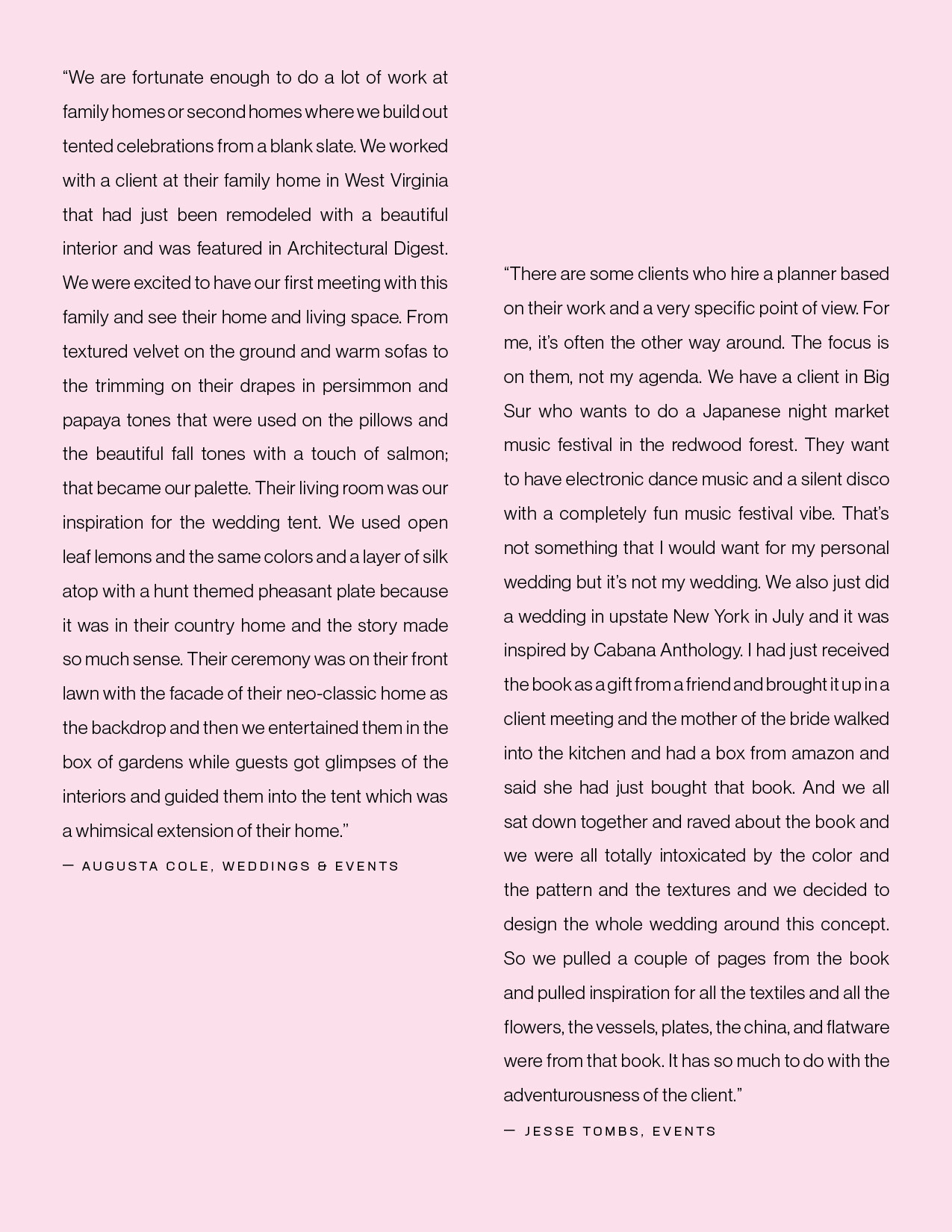
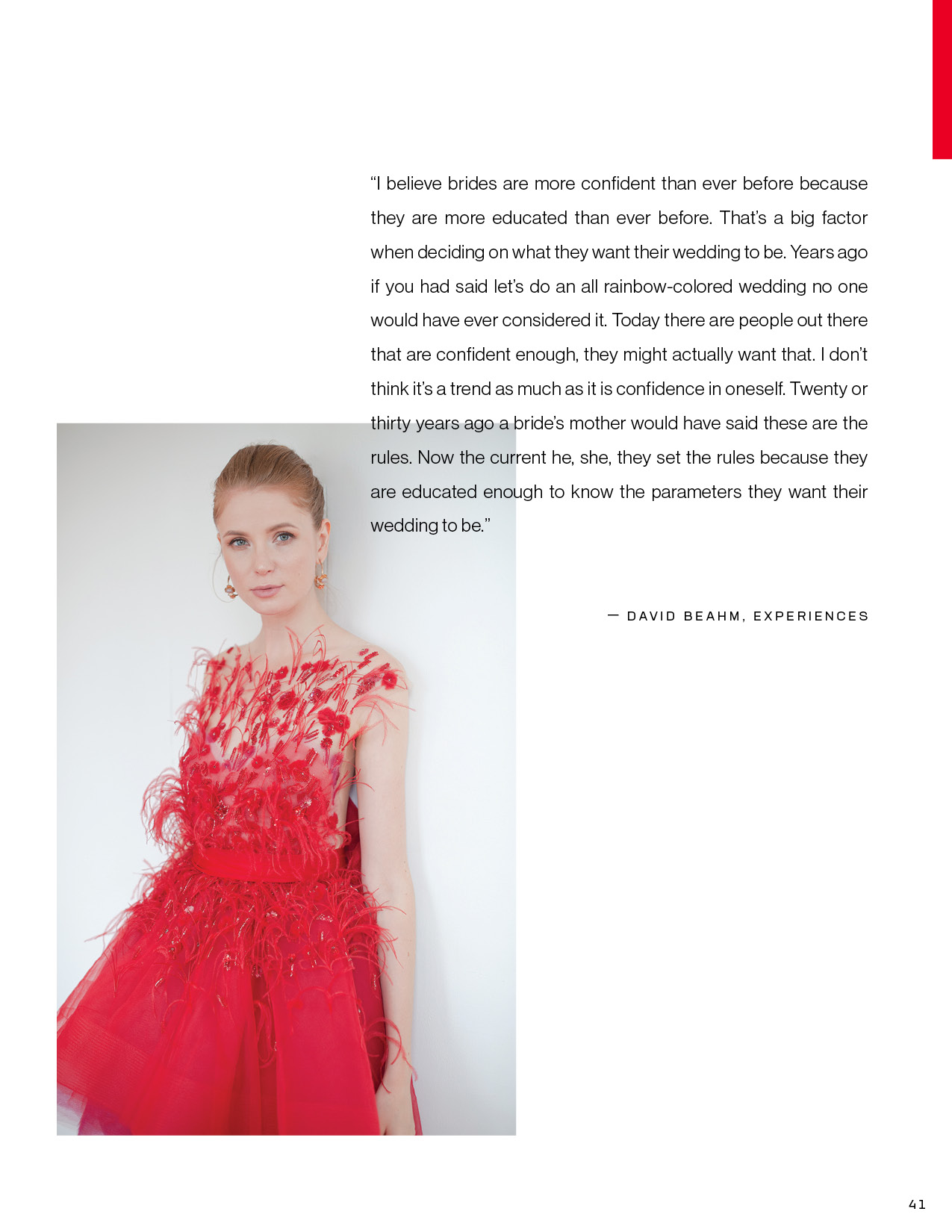
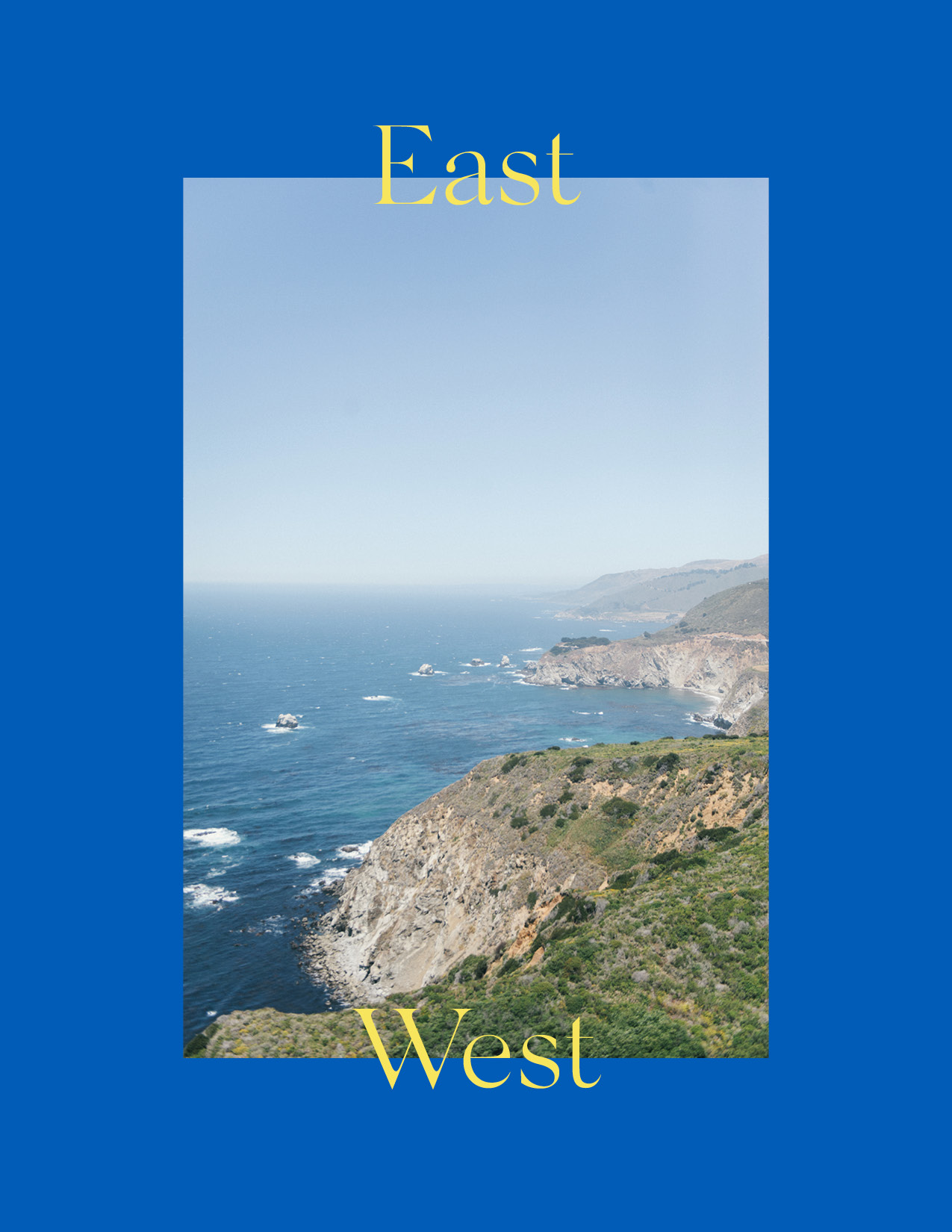
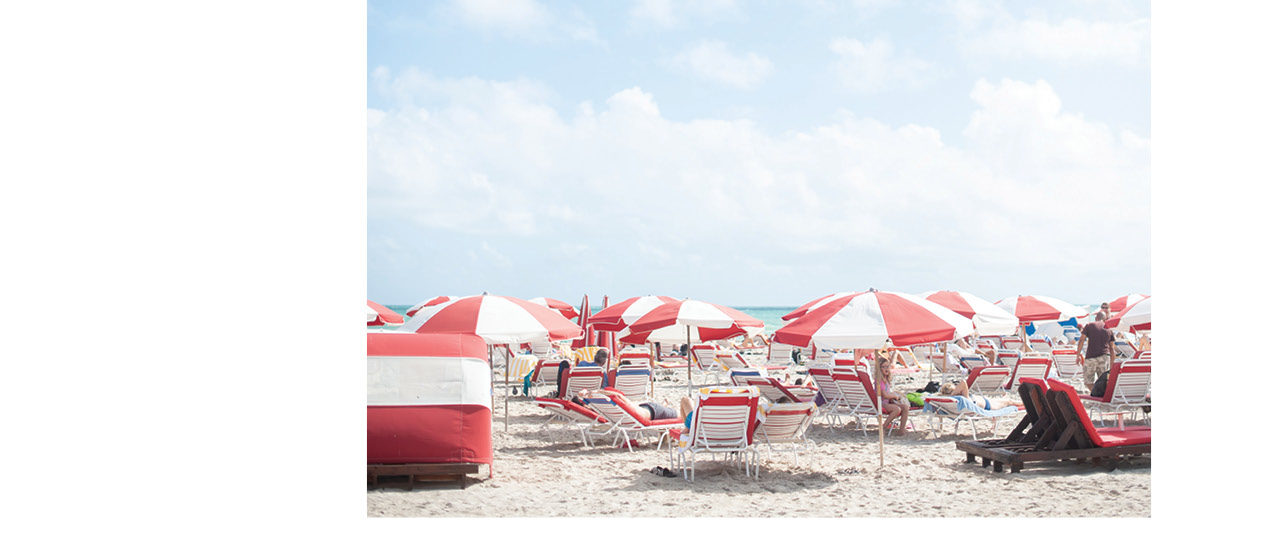
There is a profound impact on what is acceptable in creative work based on your geolocation. There is an East Coast way of doing things, and a native West Coast palette that is undeniably robust. Destination creatives have gotten themselves out of the revolving geographical door. If you’re in the Midwest you have a self-sustaining outdoor culture that knows how to get things done without fuss. If you’re in the South you better have sweet tea after church. These subcultures are in our creative DNA, and it has a very visible veneer over the way we create. On its face, it’s easy to see but it is much deeper than LAX and JFK. It stems back into our heritage in the formative years as a developing nation. The East Coast was establishing itself through structure. The West was a frontier, filled with unexpected routes and freedom to roam and dream. Rich in dynamic natural resources, one state possessed every climate that was known to America at the time. Whether you are aware of this or not it still plays a role in our creative lives and certainly in the wedding industry. I wanted to know how these geographical concepts are perceived throughout the country. -JR
“We want to attract lots of different people from lots of different backgrounds, lots of different ethnicities, lots of different economic backgrounds. The majority of the people we work with are wealthy some of them are business owners some of them are art collectors some are new money some are old money, some live in Asia some in Europe they come from all different walks of life and that is the type of client we try to attract.”
– Jesse Tombs, Events
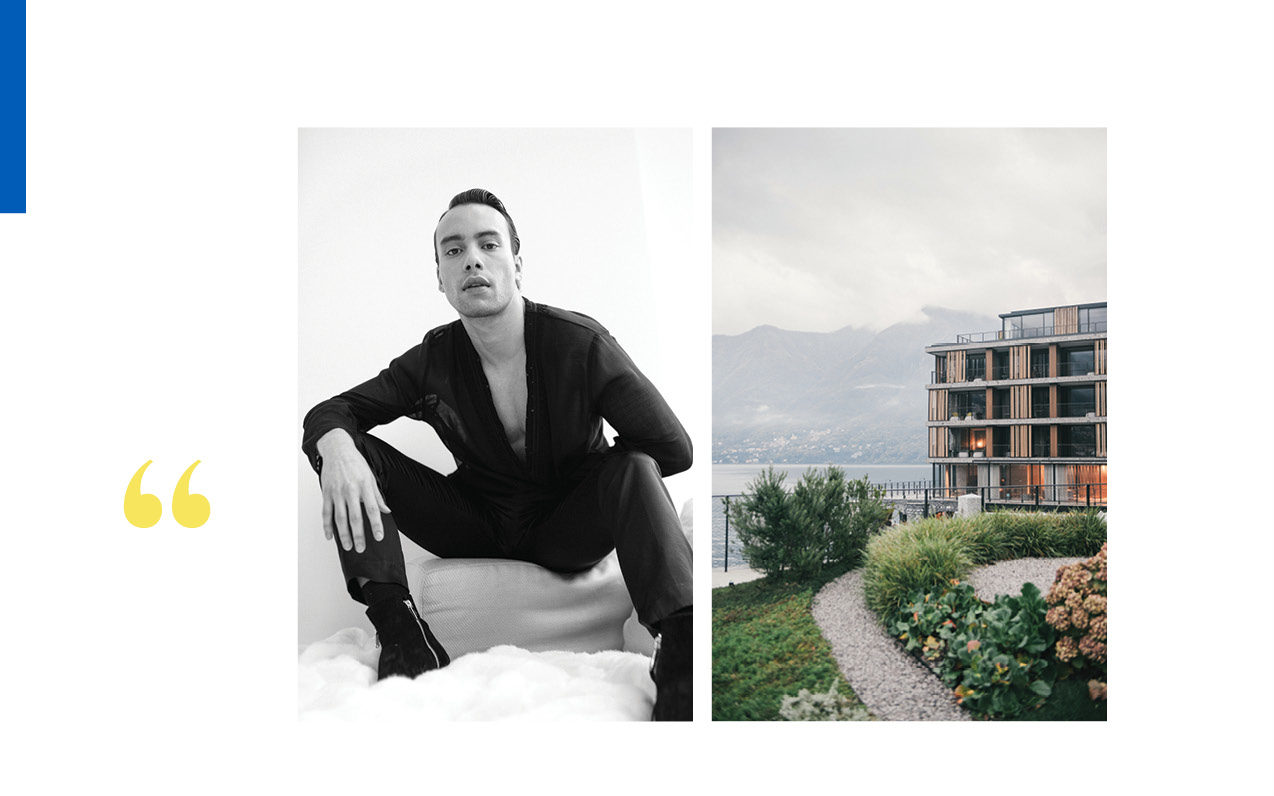
“Oh absolutely, If you go top to bottom we have so many starkly different environments to pull from. We have Joshua Tree in one breath and then we have Muir Woods, then we have the San Juans. I do feel like there is much more permission to create on this [West] Coast and our clients have that range too. I think it’s an old money new money thing. There is a lot of old wealth on the East Coast and that comes with expectation. Attachment to certain looks, on the West Coast it really is the wild wild west. I think there is a lot more movement here. But they have New York so there is that!”
– Amanda LUU, Studio Mondine
“It’s really about the marketplace, it’s a huge space in our industry – a midwest client is attracted to something different than a southeast client, there are lots of variances out there. We consider from the start who their client is, what’s their ideal market, whether it’s a destination or domestic, we look at their work, their style and we translate all of those elements with our outside perspective. Once we have all of the information we sit down and say, “okay this is your work, your market, and your client. This is what your client is looking for and here is our recommendations on how we get there.”
– Ashley Malone, Ashley & Malone
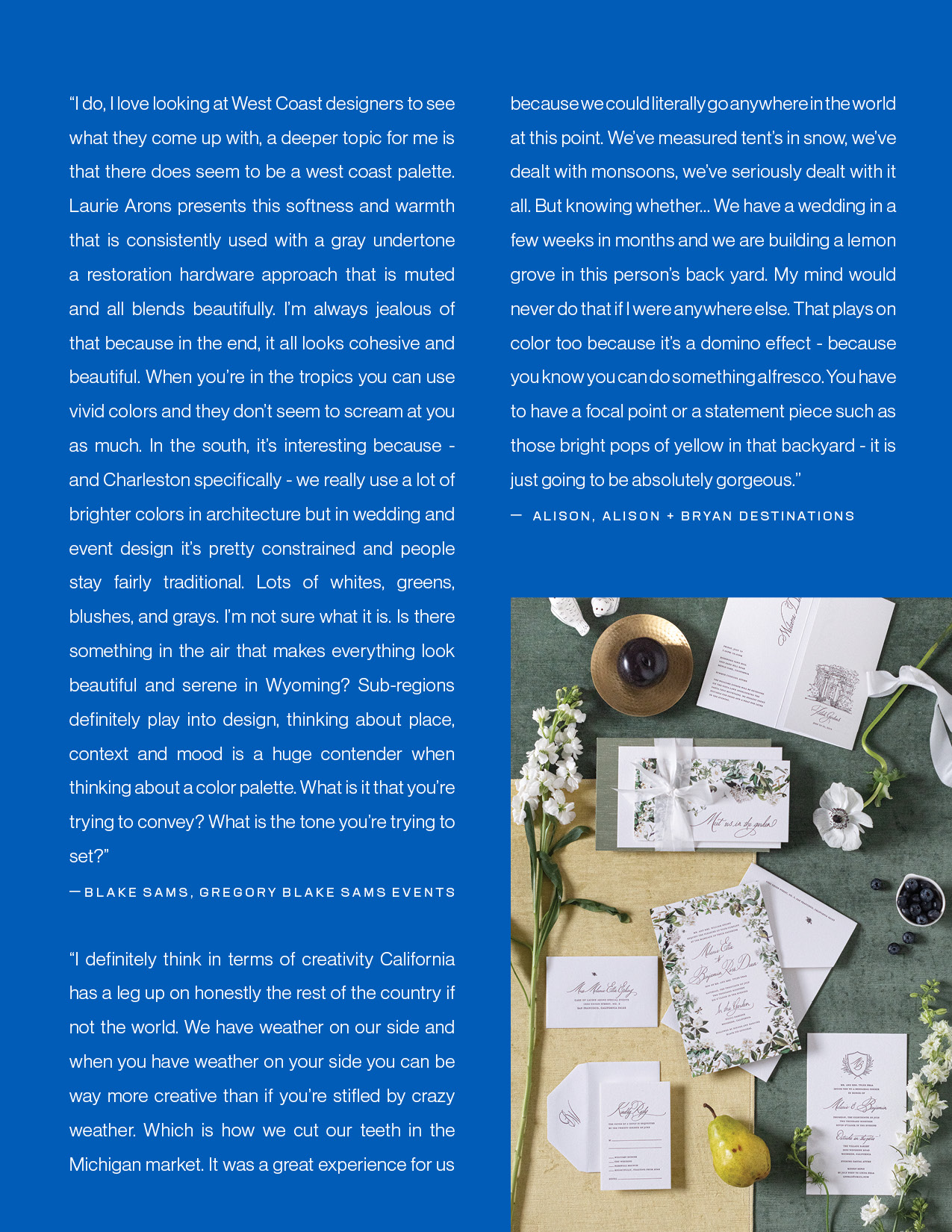
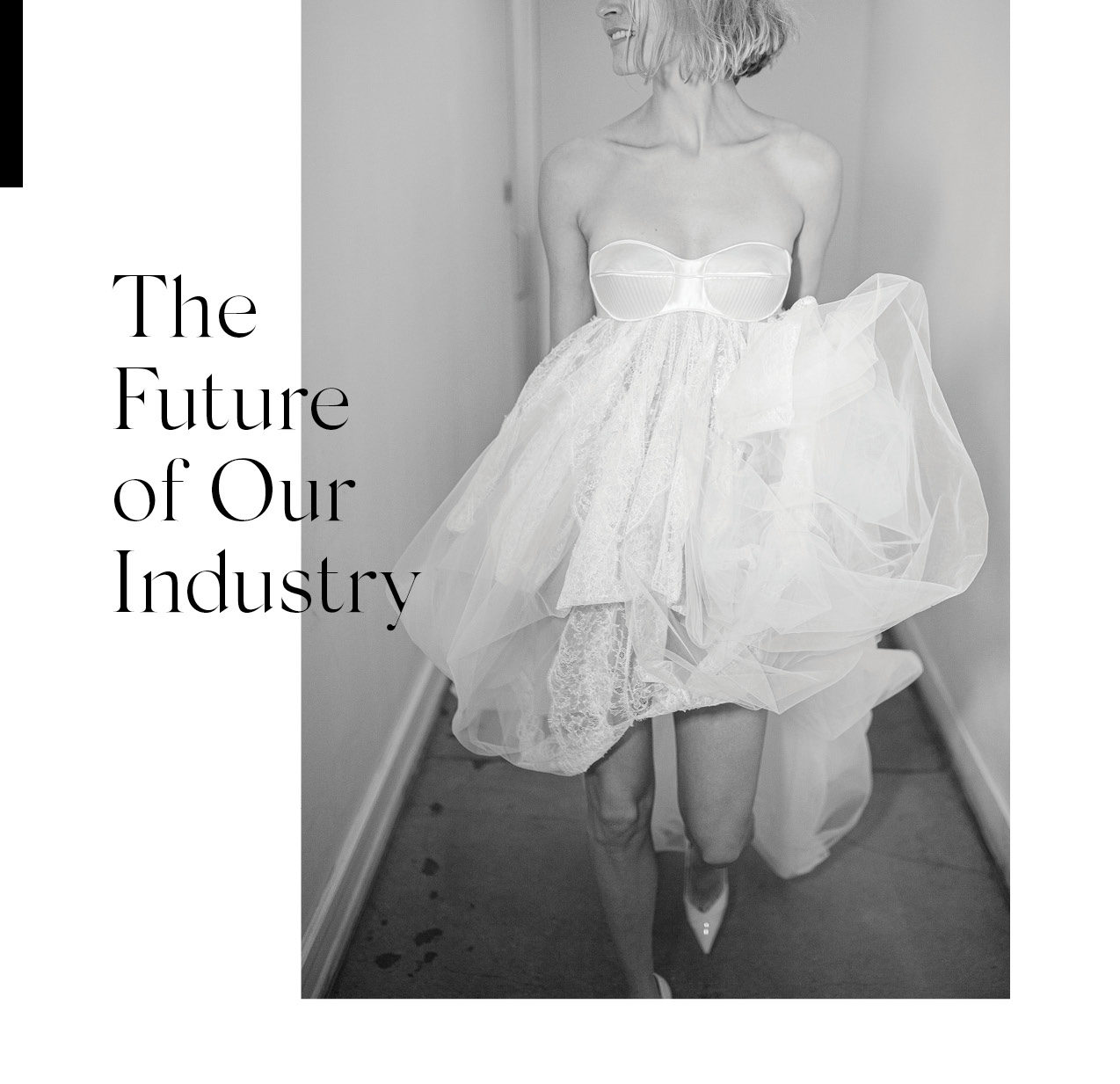
It is evident that an exciting paradigm shift is taking place within the wedding industry. For all involved, the rules are out the door. Boundaries are being pushed in all directions and creative liberty is at an all-time high. The monotone wedding editorial is old news, couples are seeking honest reflections from top to bottom which is an extraordinary presentation of color, textures, and pattern play. 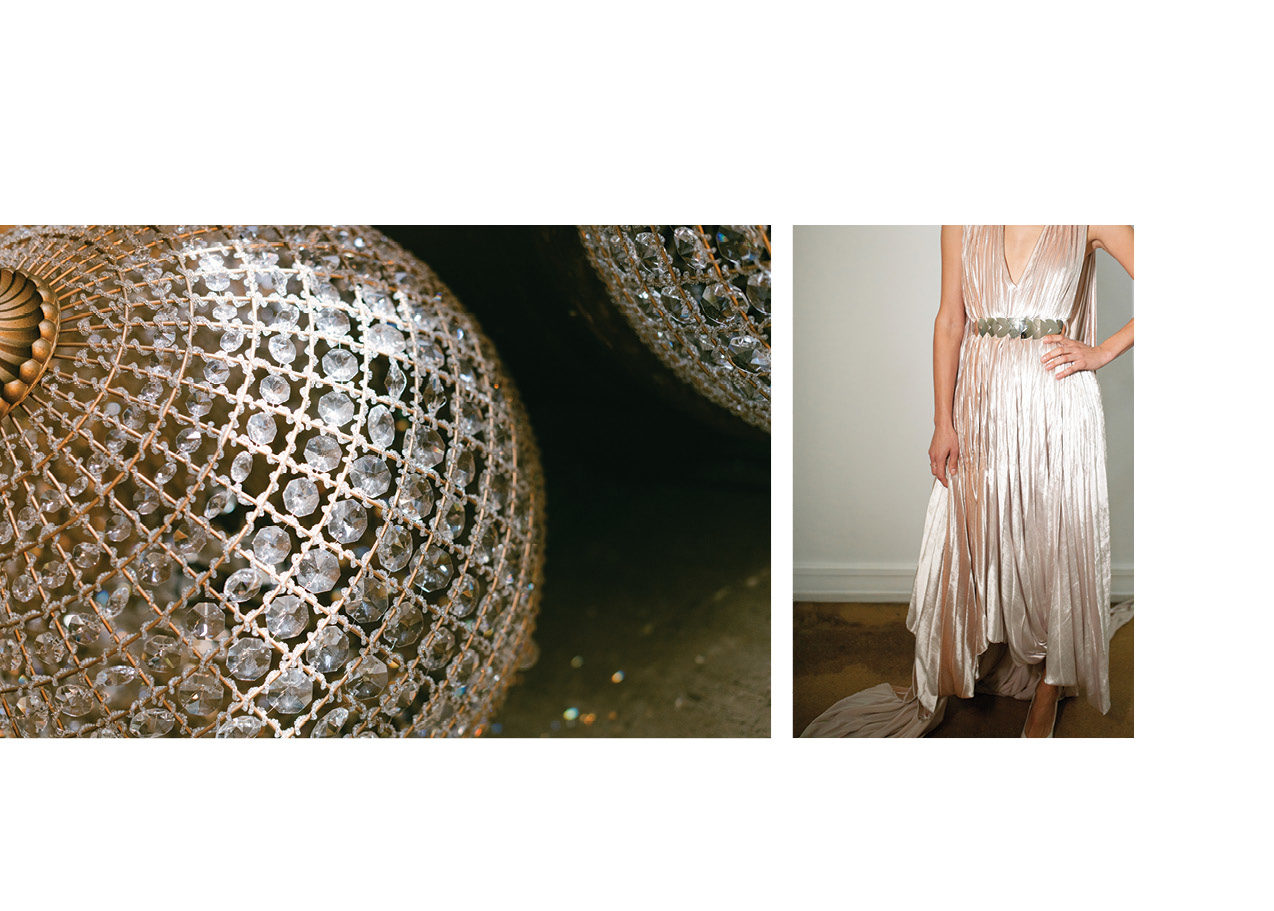
Social media is something that cannot be ignored, even though it’s not a preferred source of inspiration for many designers, rightfully so. Many design firms plead to their clients to look elsewhere for inspiration, mostly encouraging them to look within their own lives and style while designers listen, observe and construct events around their personal narratives. These creative producers take ownership in their client relationships. They are not sorry about their process, they are not meek about the path to inspiration. In retrospect, I feel that so many in our industry operate from a place of fear. Allowing the market to dictate what they create, never exploring the creative yearning from within leaving many in the revolving door of blandness and repetition for the sake of revenue and safekeeping. This rinse and repeat approach leaves many burnt, jaded, and unsatisfied in their work, ultimately creating a toxic byproduct between vendors and clients.
The great news is that we all can take ownership of our future, we can rewrite the way we do things and reshape our creative processes. We can all observe, listen and draw inspiration for the amazing environments that surround us. With a touch of confidence and a dash of determination we can bring a rich blend of diversity into our work. Knowing clients are yearning for the wow factor and guests are eager to share those sought-after Instagrammable moments, designers are pushing their work into extraordinary realms of awe and wonder. Although the power play of social media can also have ill effects on the way masses create. Amanda from Studio Mondine is keenly aware of taking intentional steps to ensure she does her part in ethical practices for a sustainable future. When I spoke with Amanda I mentioned her work from a Big Sur event that was featured in Vogue. She expressed her conflict about that event, “it’s hard for me to show that wedding, I don’t want it to go in that direction. Those bright colors hanging were all bleached, that’s incredibly harmful for those who have to bleach and equally harmful to design with. It’s full zen, rip something wonderful from the earth to be used for a day then put in a compost bag. It’s really hard, I am torn.” Amanda has begun growing relationships with local flower farmers, planting alongside for a healthier future. The fashion industry has taken a stance on animals, Netflix has taken a stance on climate dangers of Big Ag and the country has taken a stance on love and equality – how can we challenge ourselves to keep in step with the rest of the world? How can we all raise our awareness to not only create beautiful work but also use our creativity to be more colorful about stances we can take to better our process as a community? How can we take our luxury leftovers to bless someone else and make our environments stronger and happier spaces? I’ve learned that color is simply a small piece of a much grander composition. The palettes are discovered through thoughtful conversation, observation and then reflected back into the couple. I think we can stay in step with the rest of the world by authenticity reflecting back into the world what it has given us to consider. We can do it by asking questions, observing our surroundings, and listening to what our everyday lives are telling us. -JR
